Media Explorations BLOG

22/01/2024
Introduction
During our first session for Media Explorations, each of us were given a piece of technology to research. I was given the phonograph, also known as a record player, which plays prerecorded music by having a disc containing grooves mimicking sound waves be spun and a needle enters the grooves and converts them to audible sound waves. It was created by Thomas Edison in Los Angeles in 1877 and revolutionised the music industry as musicians were able to record and sell their music to be heard from anywhere in the world, not just live. Edison used the telegram, telephone and the phonautograph to help create his invention. I also learnt about many other technologies from the rest of the room and it was a good experience to learn more about people as well as technology.
We then went over the brief for this module with involves digital, analogue and memory in a video format, utilising many different mediums, such as photography, film and animation. This lead me to think about my project as a music video, utilising many of these different technologies, including the phonograph and traditional animation. I also want to experiment with stop-motion animation like the videos we watched in class but this mayh take a lot of time. I may want to work with a music student for the song aspect of this piece or utilise an existing track. Either way, I want to make it my own and have my own quirky spin on it which revolves around these different technologies, new and old.
Introduction
During our first session for Media Explorations, each of us were given a piece of technology to research. I was given the phonograph, also known as a record player, which plays prerecorded music by having a disc containing grooves mimicking sound waves be spun and a needle enters the grooves and converts them to audible sound waves. It was created by Thomas Edison in Los Angeles in 1877 and revolutionised the music industry as musicians were able to record and sell their music to be heard from anywhere in the world, not just live. Edison used the telegram, telephone and the phonautograph to help create his invention. I also learnt about many other technologies from the rest of the room and it was a good experience to learn more about people as well as technology.
We then went over the brief for this module with involves digital, analogue and memory in a video format, utilising many different mediums, such as photography, film and animation. This lead me to think about my project as a music video, utilising many of these different technologies, including the phonograph and traditional animation. I also want to experiment with stop-motion animation like the videos we watched in class but this mayh take a lot of time. I may want to work with a music student for the song aspect of this piece or utilise an existing track. Either way, I want to make it my own and have my own quirky spin on it which revolves around these different technologies, new and old.
Here are the notes from today’s lesson:
![]()
![]()


27/01/2024
Research
During my reaserch time this week, I looked at different music videos which gave me some inspiration for my piece. I want to create a music video either for a new song that I need to write or a pre-written song by an artist I like. These music videos have given me inspiration for the type of animation I may want to use in my video which will move from drawn animation and stop-motion to video. I also want to utilise the phonograph like in Kaiser Chief’s ‘Ruby’ (in the middle of the song) https://youtu.be/qObzgUfCl28?si=BY4i8Fa09UJv1paC and Oasis’ ‘Wonderwall’ https://youtu.be/bx1Bh8ZvH84?si=rHv8RJQYwAJZzOKu
A record player or phonograph would cost at least £100 for a decent one which may be a bit out of budget, so it may be worth asking the university if I could borrow one or if one of my friends have one which I could use.
Last weekend, I visited the Banksy exhibition on Regents’ Street where I got to experience lots of his work that he did for musicians as well as street art. I really like his style as a cover art for the record which will be placed on the record player and have an idea of the ‘Girl with the Balloon’ where the balloon could be in the middle of the circle and pop when it is placed over the needle of the record player.
![]()
I also like the visuals in Paula Abdul’s ‘Opposites Attract’ where she is dancing with an animated cat: https://youtu.be/xweiQukBM_k?si=fYya6w_2r6E_rXSN
I have also been watching the animated series ‘Hazbin Hotel’ on Amazon Prime which has also given me a lot of inspiration for the style of animation and the visuals in ‘Stayed Gone’ have inspired me in particular: https://youtu.be/Ai4eh_OCxvw?si=qNjytDjIjXE1CBAU
Here is a video of my previous animation work which gives an idea of my style:
https://youtu.be/fo4cvJByCmI?si=XnmIqynz87ctIgGy
https://youtu.be/F5GHj01cNr4?si=YKM9Msna35VnhvxS
(These are a bit old)
A record player or phonograph would cost at least £100 for a decent one which may be a bit out of budget, so it may be worth asking the university if I could borrow one or if one of my friends have one which I could use.
Last weekend, I visited the Banksy exhibition on Regents’ Street where I got to experience lots of his work that he did for musicians as well as street art. I really like his style as a cover art for the record which will be placed on the record player and have an idea of the ‘Girl with the Balloon’ where the balloon could be in the middle of the circle and pop when it is placed over the needle of the record player.

I also like the visuals in Paula Abdul’s ‘Opposites Attract’ where she is dancing with an animated cat: https://youtu.be/xweiQukBM_k?si=fYya6w_2r6E_rXSN
I have also been watching the animated series ‘Hazbin Hotel’ on Amazon Prime which has also given me a lot of inspiration for the style of animation and the visuals in ‘Stayed Gone’ have inspired me in particular: https://youtu.be/Ai4eh_OCxvw?si=qNjytDjIjXE1CBAU
Here is a video of my previous animation work which gives an idea of my style:
https://youtu.be/fo4cvJByCmI?si=XnmIqynz87ctIgGy
https://youtu.be/F5GHj01cNr4?si=YKM9Msna35VnhvxS
(These are a bit old)
For stop-motion, Ardman productions have given me some inspiration with their clay models. I understand, however, that this would take a very long time which I may not have if I want to utilise both stop-motion and hand-drawn animation.
This weekend, I also took some time to come up with some designs for my character which I drew on Procreate. Here are some of my designs but I would like to refine them in the future and decide on a final design:
![]()
![]()
Currently, I prefer ‘Character Design 2’ but whichever character I decide to use will depend on the feel of the song and which I feel demonstrates the mood and video character better.
This week, I learnt about the many different analogue and digital production means and how they differ from each other. I researched about my ideas and how I might go about starting my project. Although my project is quite ambitious, I believe it is possible and if I work hard, I will meet my goals and the criteria.
For next week, I need to continue to research the different analogue and digital means of production so that I am ready to come with ideas and information to the lesson.
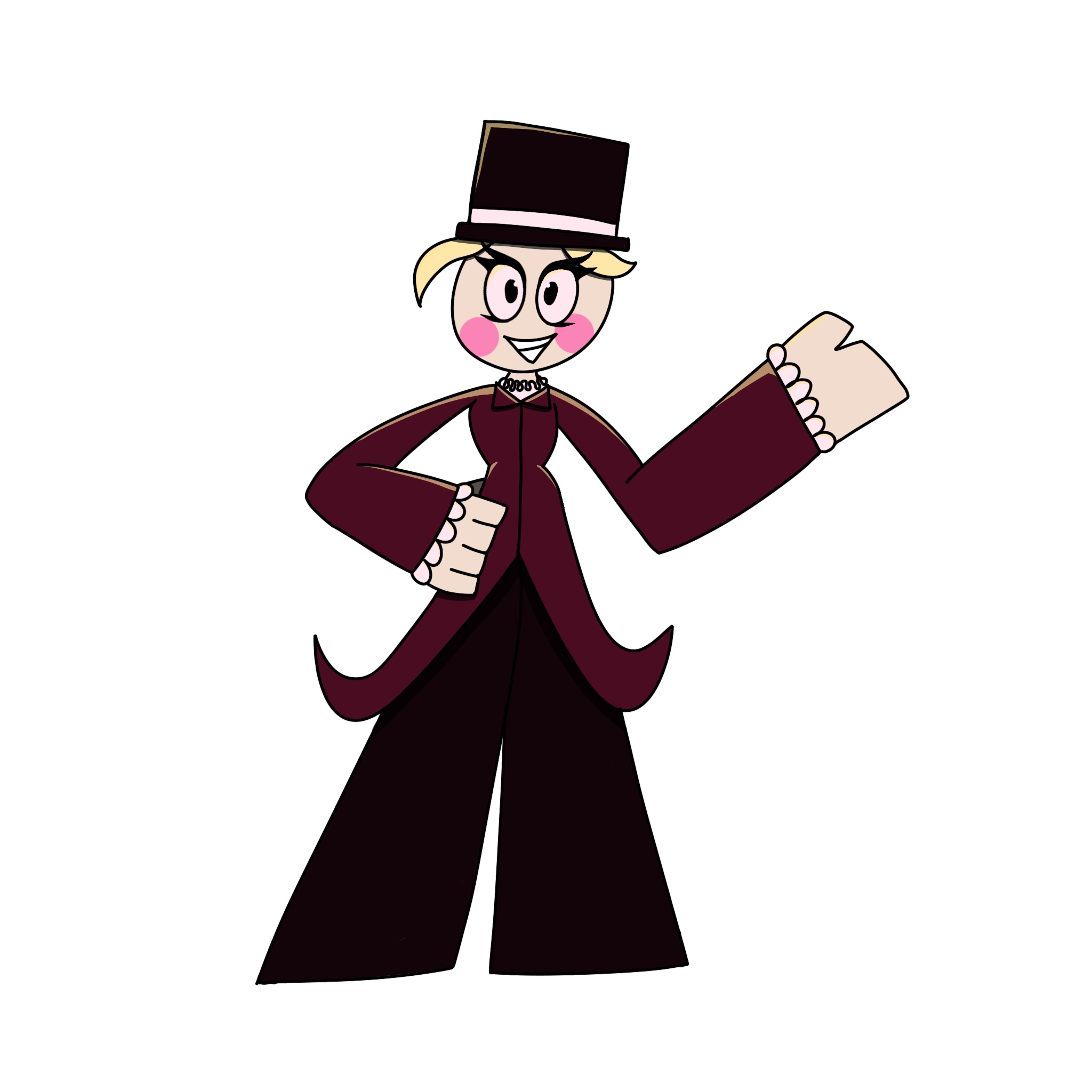
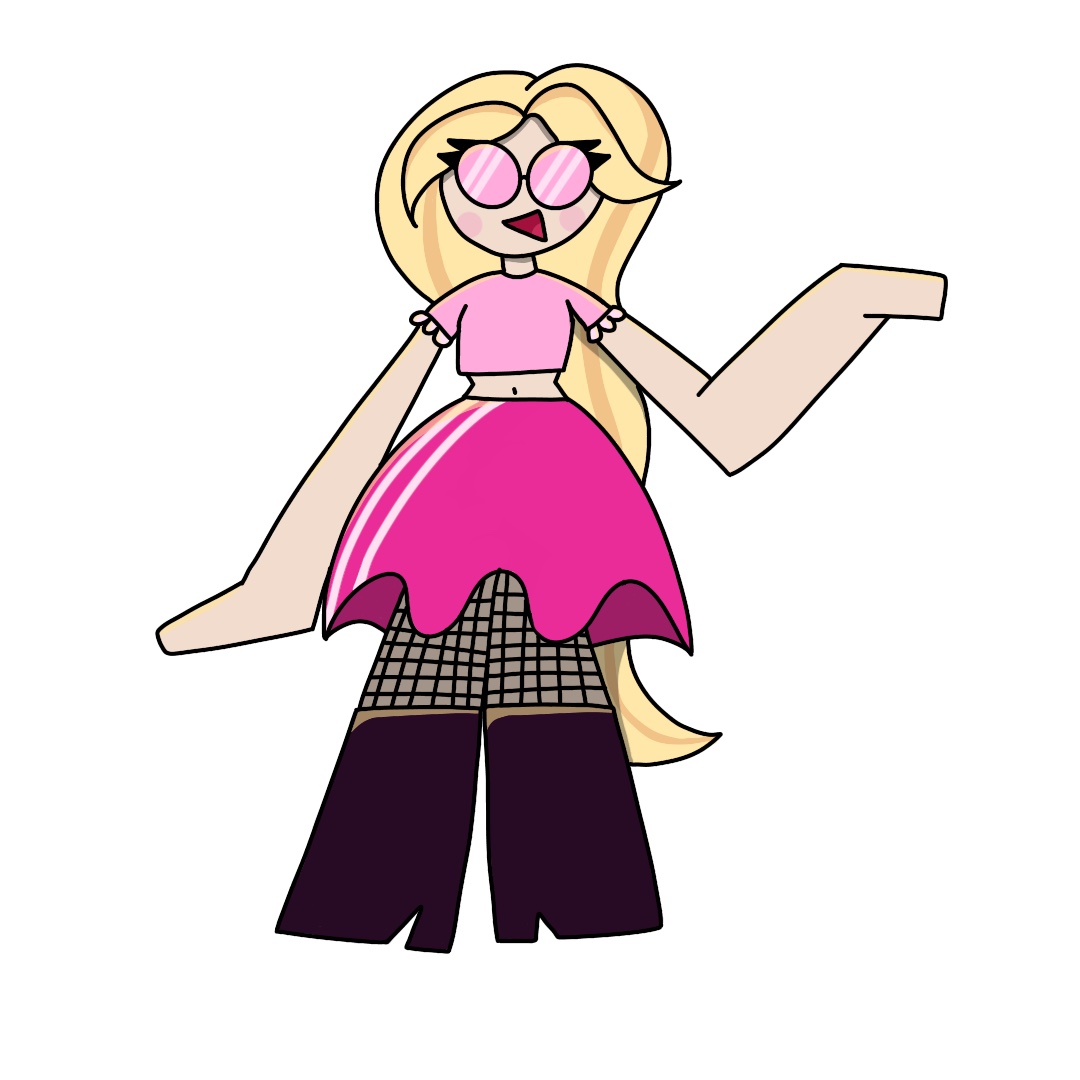
Currently, I prefer ‘Character Design 2’ but whichever character I decide to use will depend on the feel of the song and which I feel demonstrates the mood and video character better.
This week, I learnt about the many different analogue and digital production means and how they differ from each other. I researched about my ideas and how I might go about starting my project. Although my project is quite ambitious, I believe it is possible and if I work hard, I will meet my goals and the criteria.
For next week, I need to continue to research the different analogue and digital means of production so that I am ready to come with ideas and information to the lesson.
29/01/2024
Dark Room Induction
During this morning’s tutorial, we learnt about different photographers who have had an impact on photography over the years and how this has moulded how we view analogue, film photography and photograms today.
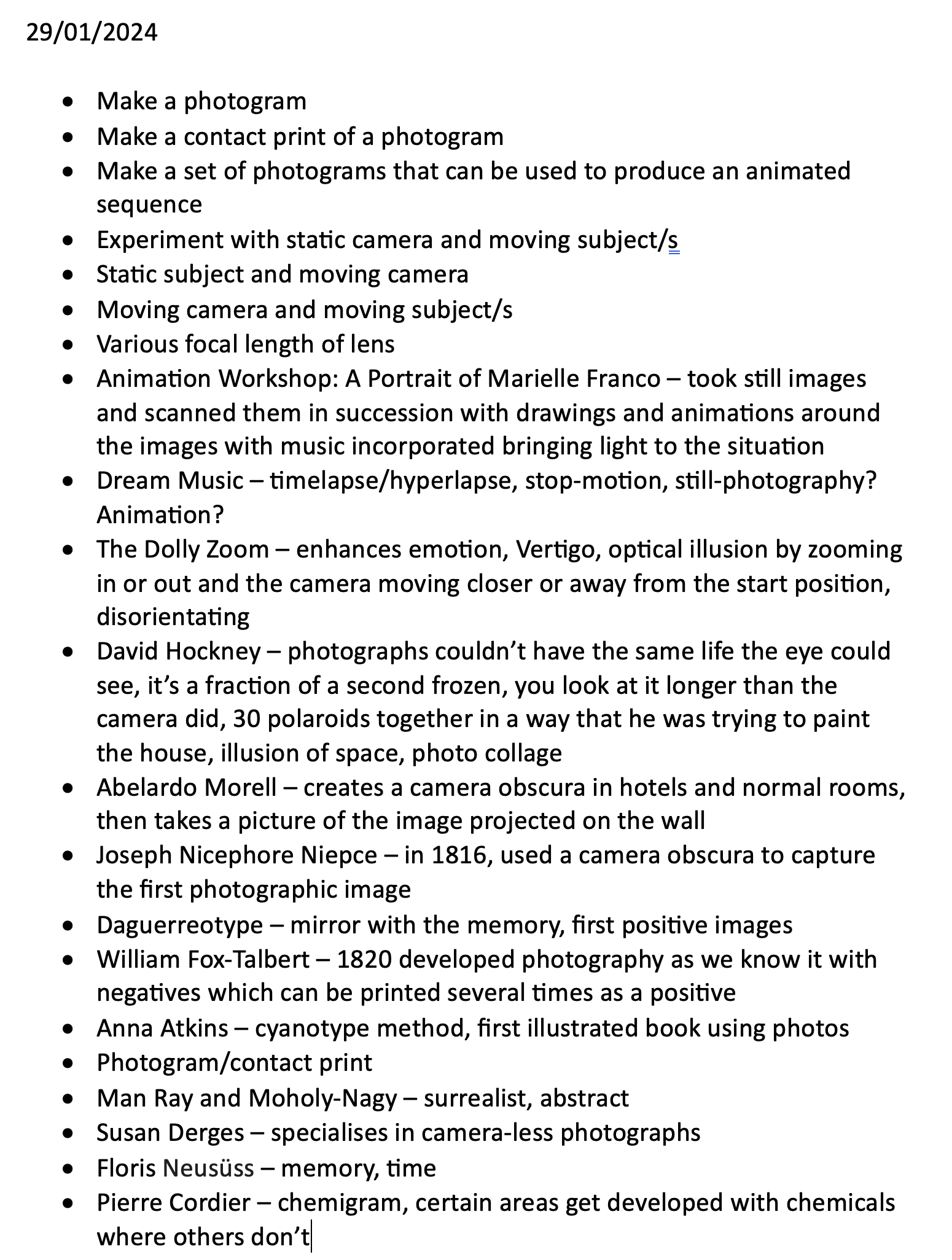
We then split into two groups and my group made our way to the dark room where we learnt how to develop negative photograms using the equipment. I learnt that it is very important not to expose the photographic paper to light before using the equipment to make a photogram or the result will be a solid black. I enjoyed changing the elements and exposure to create an effective negative. I then used this negative to make a positive which became the opposite and reflection of the negative I took. I then made a sequence of negatives which I edited in Photoshop and used Premier Pro to create a short animation with the pictures. Unfortunately, I had to leave early but next time I would like to play around with this form of photography to create an animation which could be used in my final piece. I really enjoyed this process which became easier after a while of doing it and I think the results can be interesting and unique, especially in contrast with digital photography commonly used today.
Here are my results before and after editing:
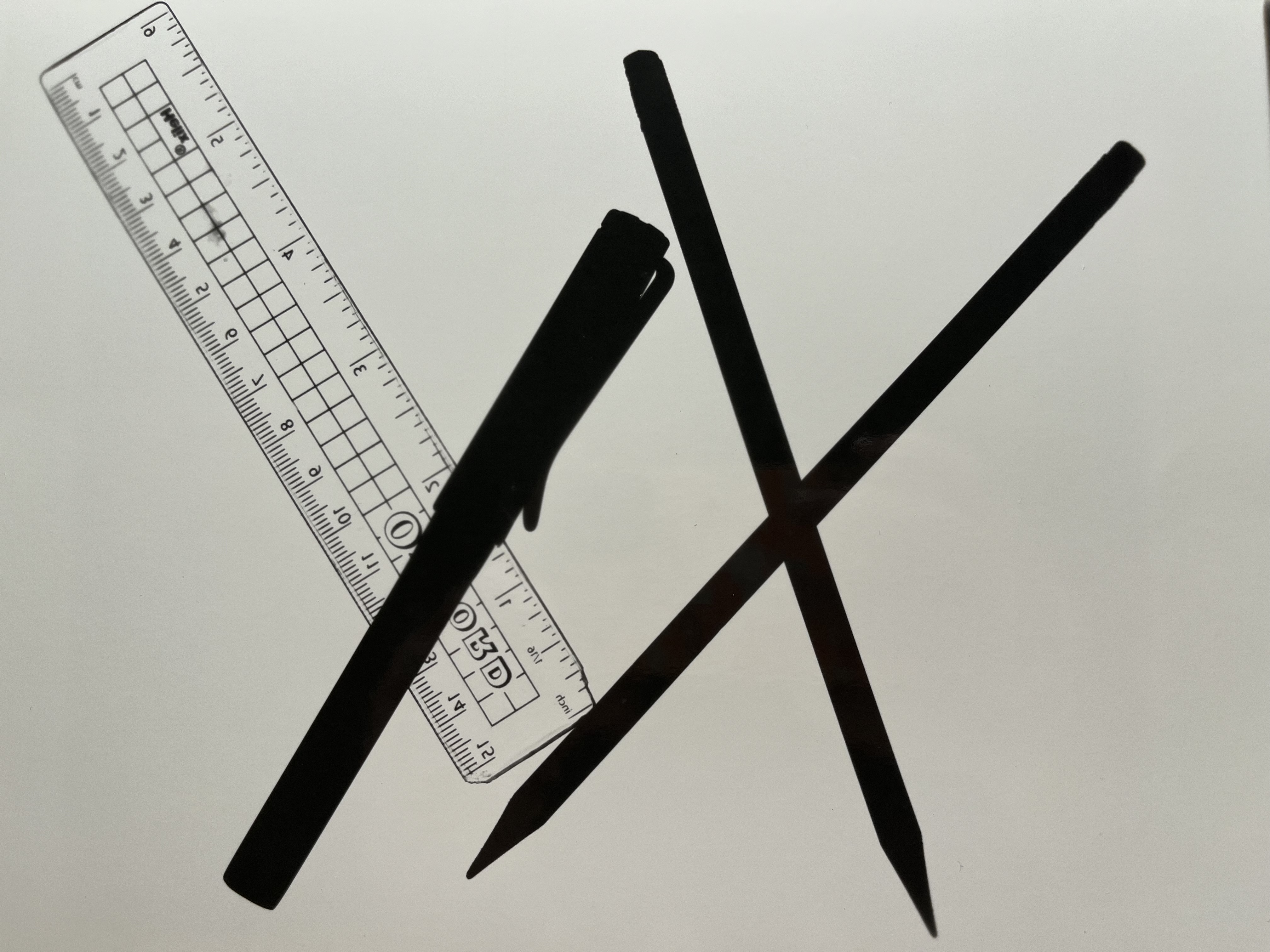
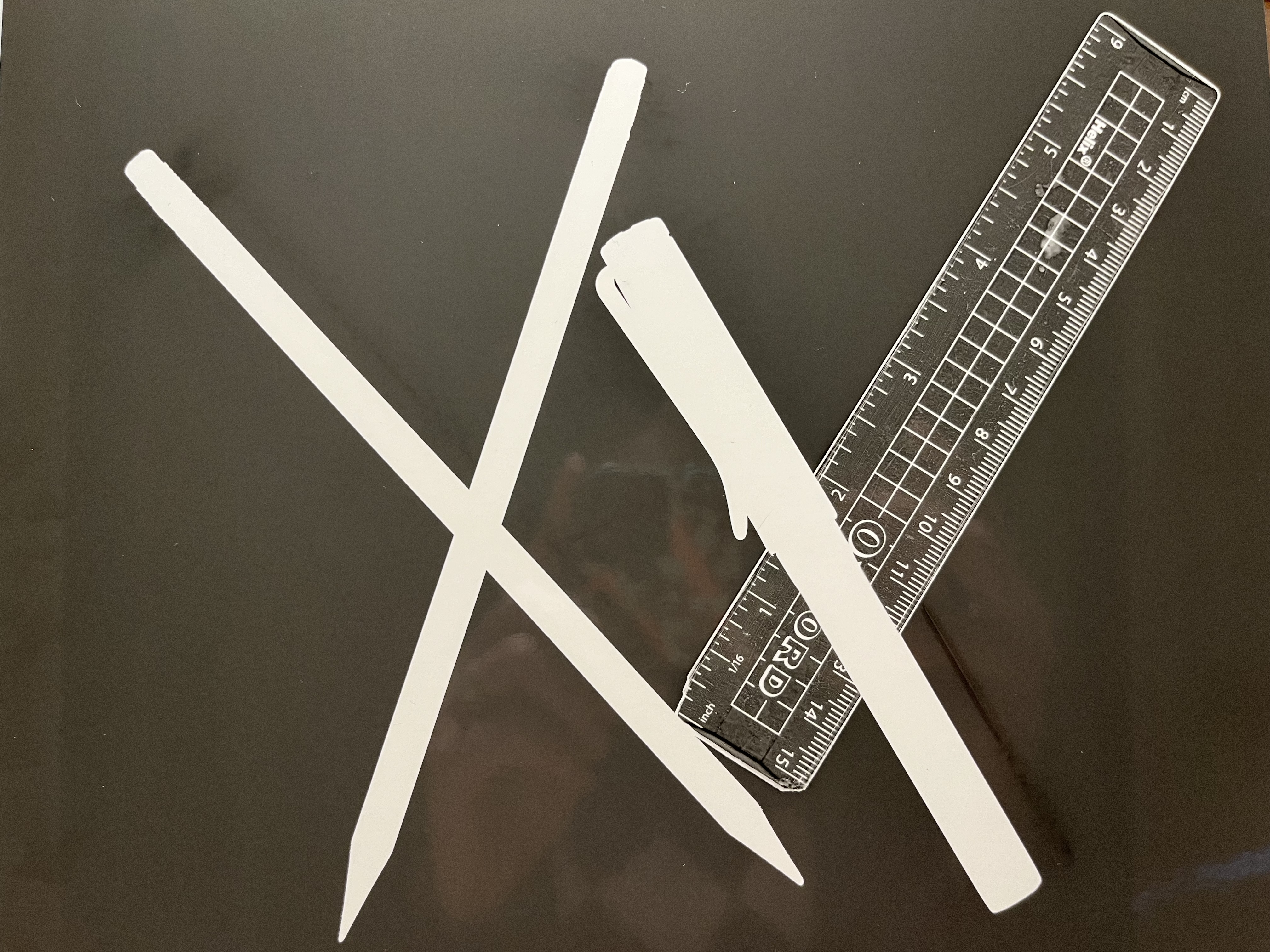

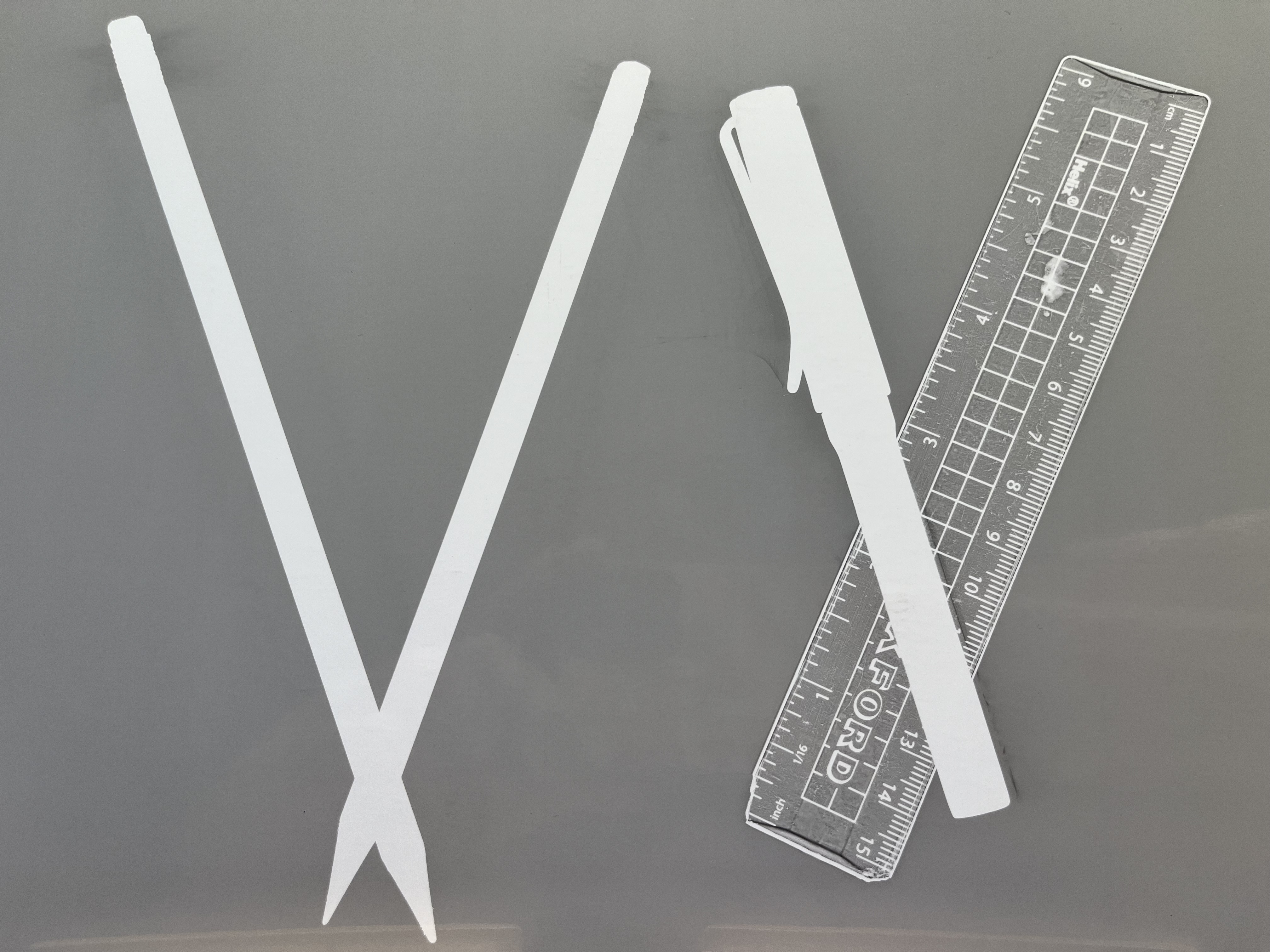

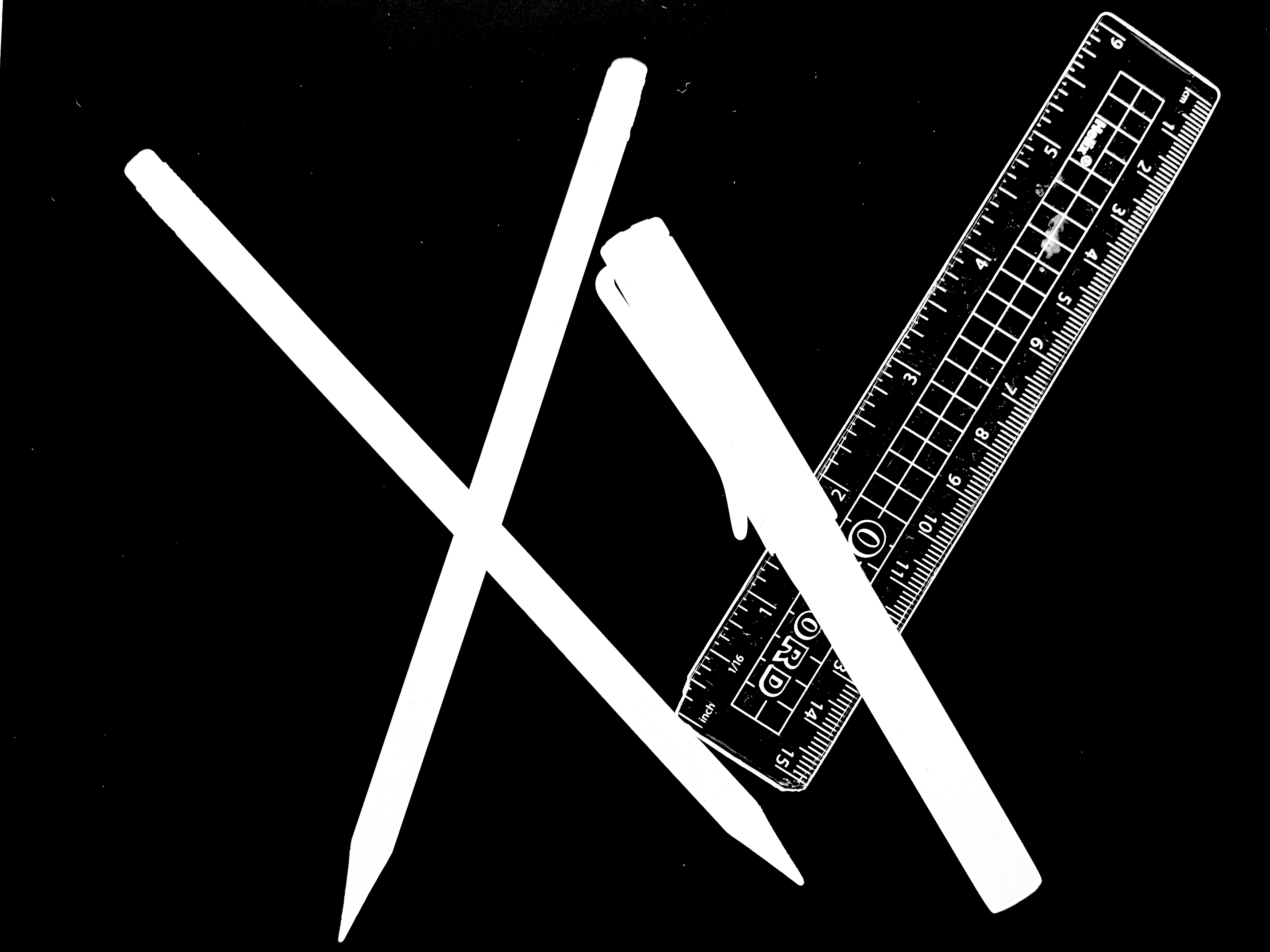


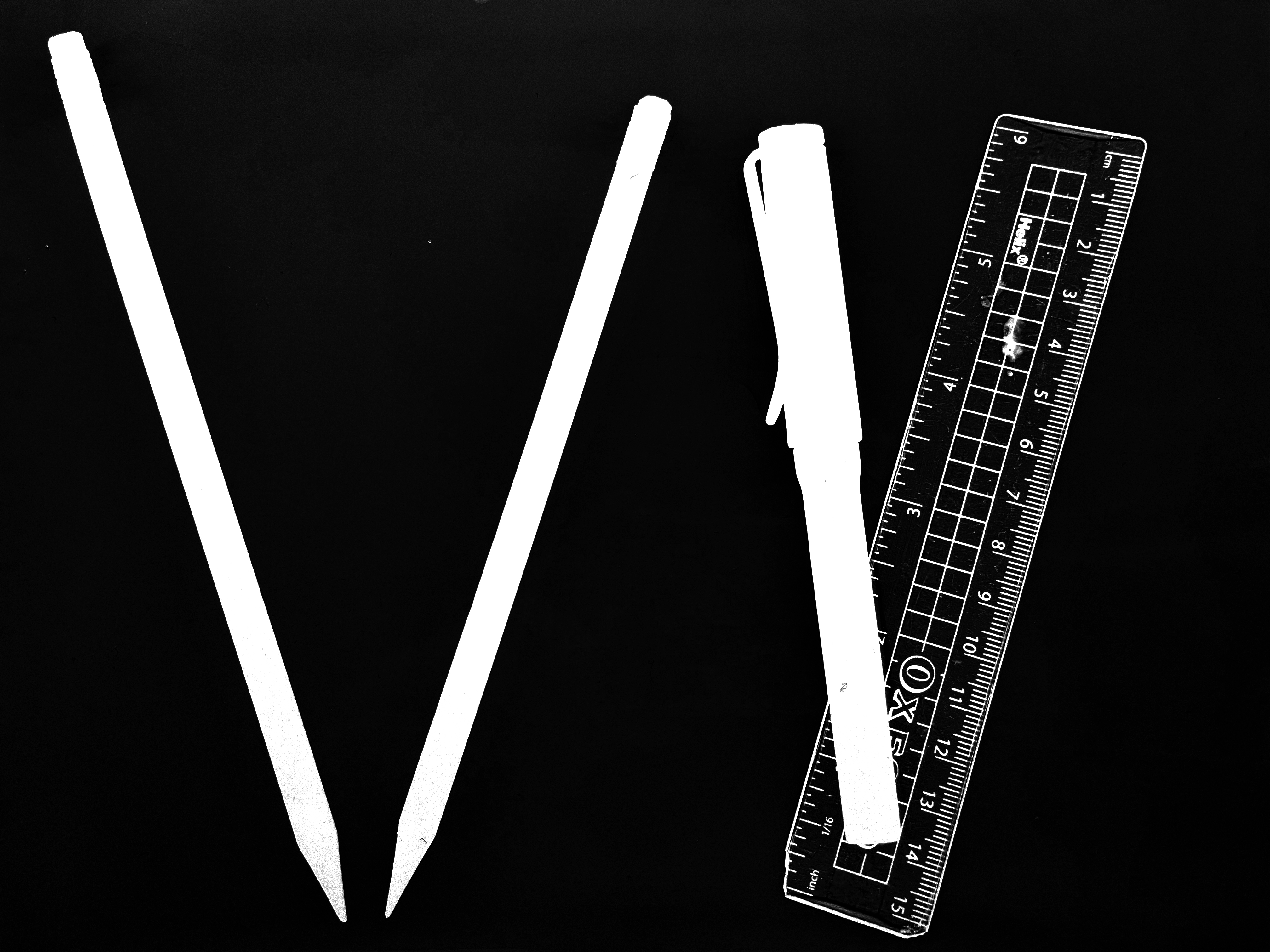

I also picked up ‘Photography and the Optical Unconscious’ by S.M. Smith and S. Sliwinski which I look forward to reading throughout the week.
04/02/2024
‘Photography and the Optical Unconscious’ by Shawn Michelle Smith and Sharon Sliwinski
This week, I decided to read ‘Photography and the Optical Unconscious’ by Shawn Michelle Smith and Sharon Sliwinski, Editors. Throughout the book, the writers acknowledge several photography professionals and philosophers, in particular Walter Benjamin, further emphasising his points on how a photograph is manipulated and perceived, bringing extra insight to the subject. The writer also goes into detail about the past of photography, how painters became photographers and how negatives were turned to positives by the hand of Henry Fox Talbot. The book also consists of a plethora of early photographs, explaining their meanings and greatness despite displaying them on a simple, white page rather than seeing them at a gallery for example. Freud’s philosophies are mentioned in relation to photography, talking about the conscious and unconscious.
‘ ”Photography, in the hands of the bourgeoisie, has become terrible weapon against truth”- Brecht’ pg 37 This quote is particularly interesting to me as is shows the more upper-class view of the photograph, mainly from a much older time. Now-a-days, almost everyone has access to a camera and can still, indeed, alter the truth with editing.
‘Hill and Adamson’s long exposures compelled their subjects to sit absolutely still before the camera for several minutes. Ans so they composed themselves, bracing against the blaring sun’ pg 57 Here, this quote is demonstrating just how far technology has come; from subjects having to wait an abnormally long time for their picture to be taken, for it only to be taken within a millisecond today.
‘The viewer sees through the photographer’s blind eye’ pg 62
‘[Barthes] does not want other people to have the leisure to stare at the photograph while learning nothing. [...] He prefers to encounter it in the periphery of lucida where an animating glance can sweep over it [...] but this, he cannot ensure strangers will do’ pg 268 I find this interesting as it is nearly impossible for Barthes to enact this kind of viewing on the audience if it is hung in a gallery but now there are ways for a picture to be shown on a screen for only a brief second to create a similar effect.
‘some of the most outspoken critics did not just distrust the camera, but they also expressed their distrust in the course of advancing a Marxist analysis of photography’ pg 289 It is important to view critics’ thinking from their own political perspective and the author here is expressing how many of these critics overlook a more leftist/Marxist approach and it is important to remember this when researching.
I also wanted to play around with flip-book animation and so made a short flip book which I could use for my final project. I did this by drawing a short animation on a pile of post-it notes and filming the animation with my phone. I then went onto Premiere Pro to edit the footage with a video of a ball bouncing so that it seamlessly becomes the image of the ball in the animation. This wasn’t particularly difficult but it did take some time to film the flip-book so that it looked right on video and to then edit the speed of the video to be in time with the ball’s movement.
Additionally, I explored the music production aspect of my piece and started to create a track I might want to use. This was very difficult as I am not a musician but I tried my best with GarageBand to create a backing track to start with. I would like to go back to this track and edit it with sounds I can find around the university to create a more organic feeling piece. Alternatively, I may want to ask a music student to help me or use Fiverr to find a songwriter: I have also had a look at this and there are many artists who can help there but, if possible, I’d rather write my own song. Additionally, I explored the music production aspect of my piece and started to create a track I might want to use. This was very difficult as I am not a musician but I tried my best with GarageBand to create a backing track to start with. I would like to go back to this track and edit it with sounds I can find around the university to create a more organic feeling piece. Alternatively, I may want to ask a music student to help me or use Fiverr to find a songwriter: I have also had a look at this and there are many artists who can help there but, if possible, I’d rather write my own song. Here is a songwriter I am interested in: https://www.fiverr.com/trismusic/be-your-ghost-songwriter?context_referrer=seller_page&ref_ctx_id=c2db1464b02c44dc841f399963134ca3&pckg_id=1&pos=1&imp_id=528c1431-1346-4acd-9e04-f4f3d0d6fb2a
This week, I learnt how to develop negative photograms in the darkrooms and, subsequently, how to turn them into positives. I enjoyed researching how the somewhat negative aspects of photography may not have changed but heightened in a modernist approach and how past critics may have been more biased than first appeared. I also enjoyed developing my animation skills an using Premiere Pro as well as analogue means to create interesting media.This week, I learnt how to develop negative photograms in the darkrooms and, subsequently, how to turn them into positives. I enjoyed researching how the somewhat negative aspects of photography may not have changed but heightened in a modernist approach and how past critics may have been more biased than first appeared. I also enjoyed developing my animation skills an using Premiere Pro as well as analogue means to create interesting media.
Next week, we will be practicing using a film camera and creating certain feelings and shots with it. Therefore, it would be beneficial to research how to use a film camera and what I might want to capture in the lesson. I also need to keep my song in mind and continue to research how to write a song of where I could get a songwriter.Next week, we will be practicing using a film camera and creating certain feelings and shots with it. Therefore, it would be beneficial to research how to use a film camera and what I might want to capture in the lesson. I also need to keep my song in mind and continue to research how to write a song of where I could get a songwriter.
05/02/2024
Film Photography
During today’s lesson, myself and Noah paired up to produce a wide range of still shots using a film camera which will, hopefully, be made into short animations later in the week. We came up with a few ideas around a subject magically making a camera appear in their hands, the petals of a flower falling and a bomb shooting out of one of the structures outside. Unfortunately, we found it difficult to reel the pictures back into the canisters and as a result, some of them may be broken or ruined. This is disappointing but, never-the-less, the pictures that will be developed properly, may be able to be played one after the other to form an animation. We also took an example video of what the picture sequence should look like and edited it to appear like separate images that had been taken on a film camera. We also added some recorded sound effects to make it fun.
11/02/2024
This week, I researched which analogue and digital media I might want to use in my final piece. These include the phonograph, stop-motion animation, hand-drawn animation, videography, photography (possibly film photography) and editing software such as Adobe Premiere Pro.
I have previously researched the phonograph but I noted that they can be quite expensive; at least £100, so it might be worth asking is the university has one which I can borrow or if my friends could lend me one.
Stop-motion animation has always intrigued me and I’ve always enjoyed this medium, especially for darker animations such as ‘Save Ralph’ https://youtu.be/G393z8s8nFY?si=fFIdObBdJqTCRKQE and Wallace and Gromit. The first stop-motion film was ‘The Humpty Dumpty Circus’ by Albert E. Smith and James Stuart Blackton produced in 1898 which utilised dolls with jointed limbs to simulate the movements of circus acrobats. I would like to use clay models in my animation as it is an easier form of stop-motion and, hopefully, won’t take as long as other forms. However, stop-motion does take a long time and so lots of careful planning will need to be done and this will amount to a small section of the piece.
I have lots of experience with hand-drawn animation and will likely use applications such as Procreate to create the style I am looking for. The first hand-drawn film was ‘Fantasmagorie’ by Emile Cohl in 1908 which depicts a day in the life of a mischievous man. https://youtu.be/aEAObel8yIE?si=CGvZMeGR3T4JSq4E Disney has been a great inspiration for me; their older hand-drawn films in particular, so I hope to include lots of this here. I may want to go to the animation suit and ask to use the facilities there.
The first digital video recorder was invented by Ampex in 1977 but wasn’t widely used until the early 1990s, especially with George Lucas’ ‘Star Wars’ prequals. Nowadays, the digital video camera is used throughout Hollywood to make the modern films we see today. I want to also use the digital camera to create a sense of modernity in my piece so that it can relate to the young audience I am aiming at. This will also make it easier for me to edit the video in Premiere Pro.
George Eastman invented the photographic paper film in 1885 before switching to celluloid in 1888-1889. His first camera was the Kodak and was offered for sale in 1888. Since then, film photography has become a beacon for retro, analogue mediums and it still widely used today. I used a film camera this week and so have experience using it which will help when I get round to taking pictures for my piece. I would also like to learn how to develop the images myself and so will speak to the photography technicians about having a session on it.
Adobe Premiere was first launched in 1991 as a video editing software by the company Adobe. It was then replaced in 2003 with Adobe Premiere Pro and has been used by professionals for a long time for video editing. The software is very advanced and my favourite software to use for video editing as it is simple yet very powerful and I have a lot of experience using it.
This week, I learnt how to take film photographs and put them in a sequence to create an animation. It was good to learn how to properly use the cameras and try them out for myself, even though we were unable to develop the photographs ourselves.
I need to continue to think more about the elements I might want to use for my project, including the final song choice. I need to think about how my narrative will be told through the medium and which analogue and digital media will best fit my theme.
12/02/2024
During today’s session, we learnt a little about how to use different cameras effectively before going out and trying ourselves. I worked with Noah and Ann with a large-format analogue camera to take a few portraits and shots outside. It was very interesting to learn how to load and unload the film as well as set up the camera and use effectively. This process was arduous yet, hopefully, rewarding and was a great experience all round. We only took a total of 7 photographs which will be developed over the week.
We also used a DSLR camera with different focal lengths to see the difference. I modelled while Noah took lots of photos of me, trying to keep the framing the same throughout.
Finally, myself and Noah took the developed film from last week and began experimenting with scanning the film to the computer. Some of the film did not come out too well so instead, we somewhat destroyed this film and scanned it later to get some interesting results. These scans have helped with my own project as I may want to use some of these when I edit the piece.
04/02/2024
‘Photography and the Optical Unconscious’ by Shawn Michelle Smith and Sharon Sliwinski
This week, I decided to read ‘Photography and the Optical Unconscious’ by Shawn Michelle Smith and Sharon Sliwinski, Editors. Throughout the book, the writers acknowledge several photography professionals and philosophers, in particular Walter Benjamin, further emphasising his points on how a photograph is manipulated and perceived, bringing extra insight to the subject. The writer also goes into detail about the past of photography, how painters became photographers and how negatives were turned to positives by the hand of Henry Fox Talbot. The book also consists of a plethora of early photographs, explaining their meanings and greatness despite displaying them on a simple, white page rather than seeing them at a gallery for example. Freud’s philosophies are mentioned in relation to photography, talking about the conscious and unconscious.
‘ ”Photography, in the hands of the bourgeoisie, has become terrible weapon against truth”- Brecht’ pg 37 This quote is particularly interesting to me as is shows the more upper-class view of the photograph, mainly from a much older time. Now-a-days, almost everyone has access to a camera and can still, indeed, alter the truth with editing.
‘Hill and Adamson’s long exposures compelled their subjects to sit absolutely still before the camera for several minutes. Ans so they composed themselves, bracing against the blaring sun’ pg 57 Here, this quote is demonstrating just how far technology has come; from subjects having to wait an abnormally long time for their picture to be taken, for it only to be taken within a millisecond today.
‘The viewer sees through the photographer’s blind eye’ pg 62
‘[Barthes] does not want other people to have the leisure to stare at the photograph while learning nothing. [...] He prefers to encounter it in the periphery of lucida where an animating glance can sweep over it [...] but this, he cannot ensure strangers will do’ pg 268 I find this interesting as it is nearly impossible for Barthes to enact this kind of viewing on the audience if it is hung in a gallery but now there are ways for a picture to be shown on a screen for only a brief second to create a similar effect.
‘some of the most outspoken critics did not just distrust the camera, but they also expressed their distrust in the course of advancing a Marxist analysis of photography’ pg 289 It is important to view critics’ thinking from their own political perspective and the author here is expressing how many of these critics overlook a more leftist/Marxist approach and it is important to remember this when researching.
I also wanted to play around with flip-book animation and so made a short flip book which I could use for my final project. I did this by drawing a short animation on a pile of post-it notes and filming the animation with my phone. I then went onto Premiere Pro to edit the footage with a video of a ball bouncing so that it seamlessly becomes the image of the ball in the animation. This wasn’t particularly difficult but it did take some time to film the flip-book so that it looked right on video and to then edit the speed of the video to be in time with the ball’s movement.
Additionally, I explored the music production aspect of my piece and started to create a track I might want to use. This was very difficult as I am not a musician but I tried my best with GarageBand to create a backing track to start with. I would like to go back to this track and edit it with sounds I can find around the university to create a more organic feeling piece. Alternatively, I may want to ask a music student to help me or use Fiverr to find a songwriter: I have also had a look at this and there are many artists who can help there but, if possible, I’d rather write my own song. Additionally, I explored the music production aspect of my piece and started to create a track I might want to use. This was very difficult as I am not a musician but I tried my best with GarageBand to create a backing track to start with. I would like to go back to this track and edit it with sounds I can find around the university to create a more organic feeling piece. Alternatively, I may want to ask a music student to help me or use Fiverr to find a songwriter: I have also had a look at this and there are many artists who can help there but, if possible, I’d rather write my own song. Here is a songwriter I am interested in: https://www.fiverr.com/trismusic/be-your-ghost-songwriter?context_referrer=seller_page&ref_ctx_id=c2db1464b02c44dc841f399963134ca3&pckg_id=1&pos=1&imp_id=528c1431-1346-4acd-9e04-f4f3d0d6fb2a
This week, I learnt how to develop negative photograms in the darkrooms and, subsequently, how to turn them into positives. I enjoyed researching how the somewhat negative aspects of photography may not have changed but heightened in a modernist approach and how past critics may have been more biased than first appeared. I also enjoyed developing my animation skills an using Premiere Pro as well as analogue means to create interesting media.This week, I learnt how to develop negative photograms in the darkrooms and, subsequently, how to turn them into positives. I enjoyed researching how the somewhat negative aspects of photography may not have changed but heightened in a modernist approach and how past critics may have been more biased than first appeared. I also enjoyed developing my animation skills an using Premiere Pro as well as analogue means to create interesting media.
Next week, we will be practicing using a film camera and creating certain feelings and shots with it. Therefore, it would be beneficial to research how to use a film camera and what I might want to capture in the lesson. I also need to keep my song in mind and continue to research how to write a song of where I could get a songwriter.Next week, we will be practicing using a film camera and creating certain feelings and shots with it. Therefore, it would be beneficial to research how to use a film camera and what I might want to capture in the lesson. I also need to keep my song in mind and continue to research how to write a song of where I could get a songwriter.
05/02/2024
Film Photography
During today’s lesson, myself and Noah paired up to produce a wide range of still shots using a film camera which will, hopefully, be made into short animations later in the week. We came up with a few ideas around a subject magically making a camera appear in their hands, the petals of a flower falling and a bomb shooting out of one of the structures outside. Unfortunately, we found it difficult to reel the pictures back into the canisters and as a result, some of them may be broken or ruined. This is disappointing but, never-the-less, the pictures that will be developed properly, may be able to be played one after the other to form an animation. We also took an example video of what the picture sequence should look like and edited it to appear like separate images that had been taken on a film camera. We also added some recorded sound effects to make it fun.
11/02/2024
Research into Project Media
This week, I researched which analogue and digital media I might want to use in my final piece. These include the phonograph, stop-motion animation, hand-drawn animation, videography, photography (possibly film photography) and editing software such as Adobe Premiere Pro.
I have previously researched the phonograph but I noted that they can be quite expensive; at least £100, so it might be worth asking is the university has one which I can borrow or if my friends could lend me one.
Stop-motion animation has always intrigued me and I’ve always enjoyed this medium, especially for darker animations such as ‘Save Ralph’ https://youtu.be/G393z8s8nFY?si=fFIdObBdJqTCRKQE and Wallace and Gromit. The first stop-motion film was ‘The Humpty Dumpty Circus’ by Albert E. Smith and James Stuart Blackton produced in 1898 which utilised dolls with jointed limbs to simulate the movements of circus acrobats. I would like to use clay models in my animation as it is an easier form of stop-motion and, hopefully, won’t take as long as other forms. However, stop-motion does take a long time and so lots of careful planning will need to be done and this will amount to a small section of the piece.
I have lots of experience with hand-drawn animation and will likely use applications such as Procreate to create the style I am looking for. The first hand-drawn film was ‘Fantasmagorie’ by Emile Cohl in 1908 which depicts a day in the life of a mischievous man. https://youtu.be/aEAObel8yIE?si=CGvZMeGR3T4JSq4E Disney has been a great inspiration for me; their older hand-drawn films in particular, so I hope to include lots of this here. I may want to go to the animation suit and ask to use the facilities there.
The first digital video recorder was invented by Ampex in 1977 but wasn’t widely used until the early 1990s, especially with George Lucas’ ‘Star Wars’ prequals. Nowadays, the digital video camera is used throughout Hollywood to make the modern films we see today. I want to also use the digital camera to create a sense of modernity in my piece so that it can relate to the young audience I am aiming at. This will also make it easier for me to edit the video in Premiere Pro.
George Eastman invented the photographic paper film in 1885 before switching to celluloid in 1888-1889. His first camera was the Kodak and was offered for sale in 1888. Since then, film photography has become a beacon for retro, analogue mediums and it still widely used today. I used a film camera this week and so have experience using it which will help when I get round to taking pictures for my piece. I would also like to learn how to develop the images myself and so will speak to the photography technicians about having a session on it.
Adobe Premiere was first launched in 1991 as a video editing software by the company Adobe. It was then replaced in 2003 with Adobe Premiere Pro and has been used by professionals for a long time for video editing. The software is very advanced and my favourite software to use for video editing as it is simple yet very powerful and I have a lot of experience using it.
This week, I learnt how to take film photographs and put them in a sequence to create an animation. It was good to learn how to properly use the cameras and try them out for myself, even though we were unable to develop the photographs ourselves.
I need to continue to think more about the elements I might want to use for my project, including the final song choice. I need to think about how my narrative will be told through the medium and which analogue and digital media will best fit my theme.
12/02/2024
Experimenting
During today’s session, we learnt a little about how to use different cameras effectively before going out and trying ourselves. I worked with Noah and Ann with a large-format analogue camera to take a few portraits and shots outside. It was very interesting to learn how to load and unload the film as well as set up the camera and use effectively. This process was arduous yet, hopefully, rewarding and was a great experience all round. We only took a total of 7 photographs which will be developed over the week.
We also used a DSLR camera with different focal lengths to see the difference. I modelled while Noah took lots of photos of me, trying to keep the framing the same throughout.
Finally, myself and Noah took the developed film from last week and began experimenting with scanning the film to the computer. Some of the film did not come out too well so instead, we somewhat destroyed this film and scanned it later to get some interesting results. These scans have helped with my own project as I may want to use some of these when I edit the piece.
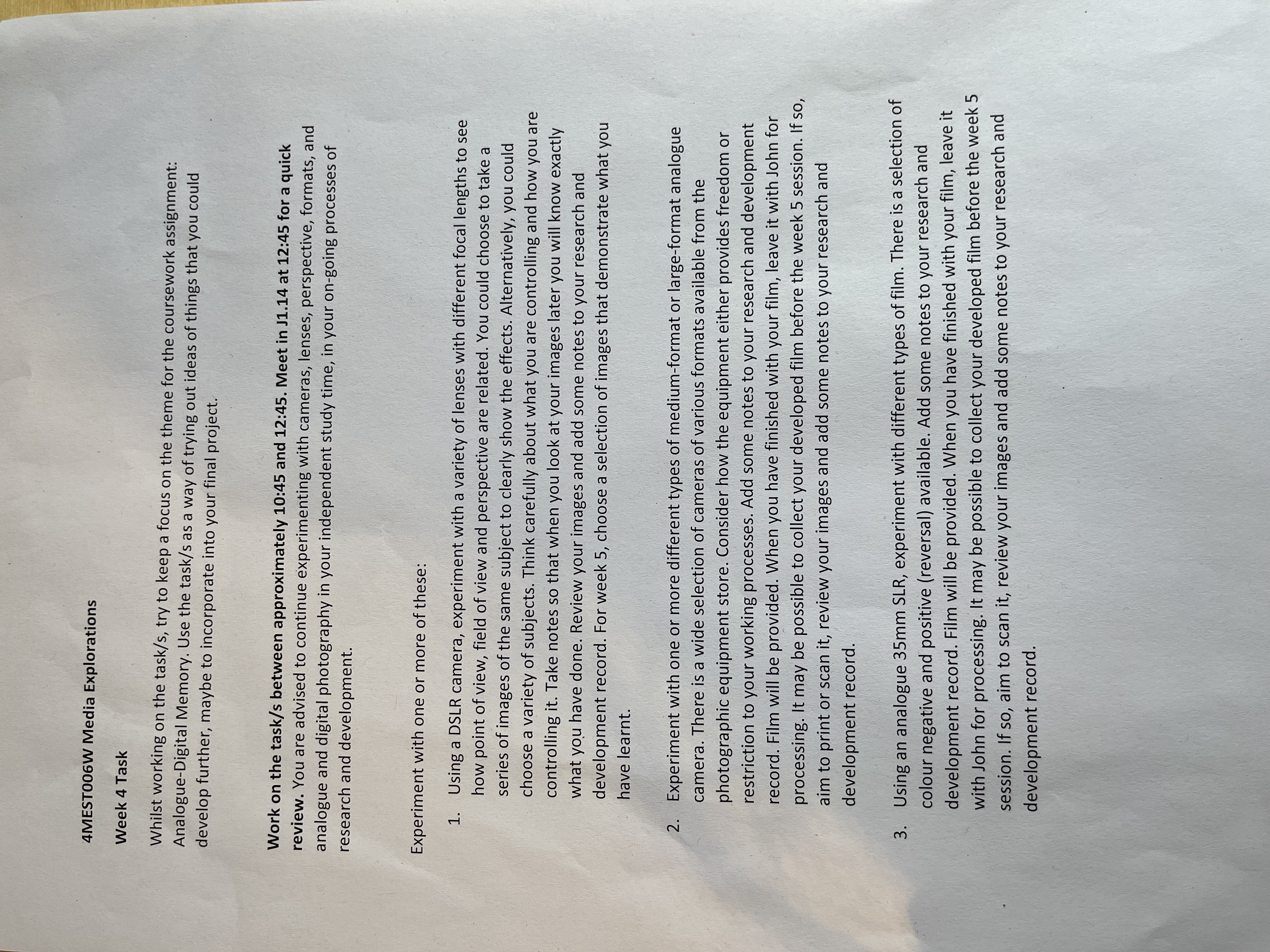
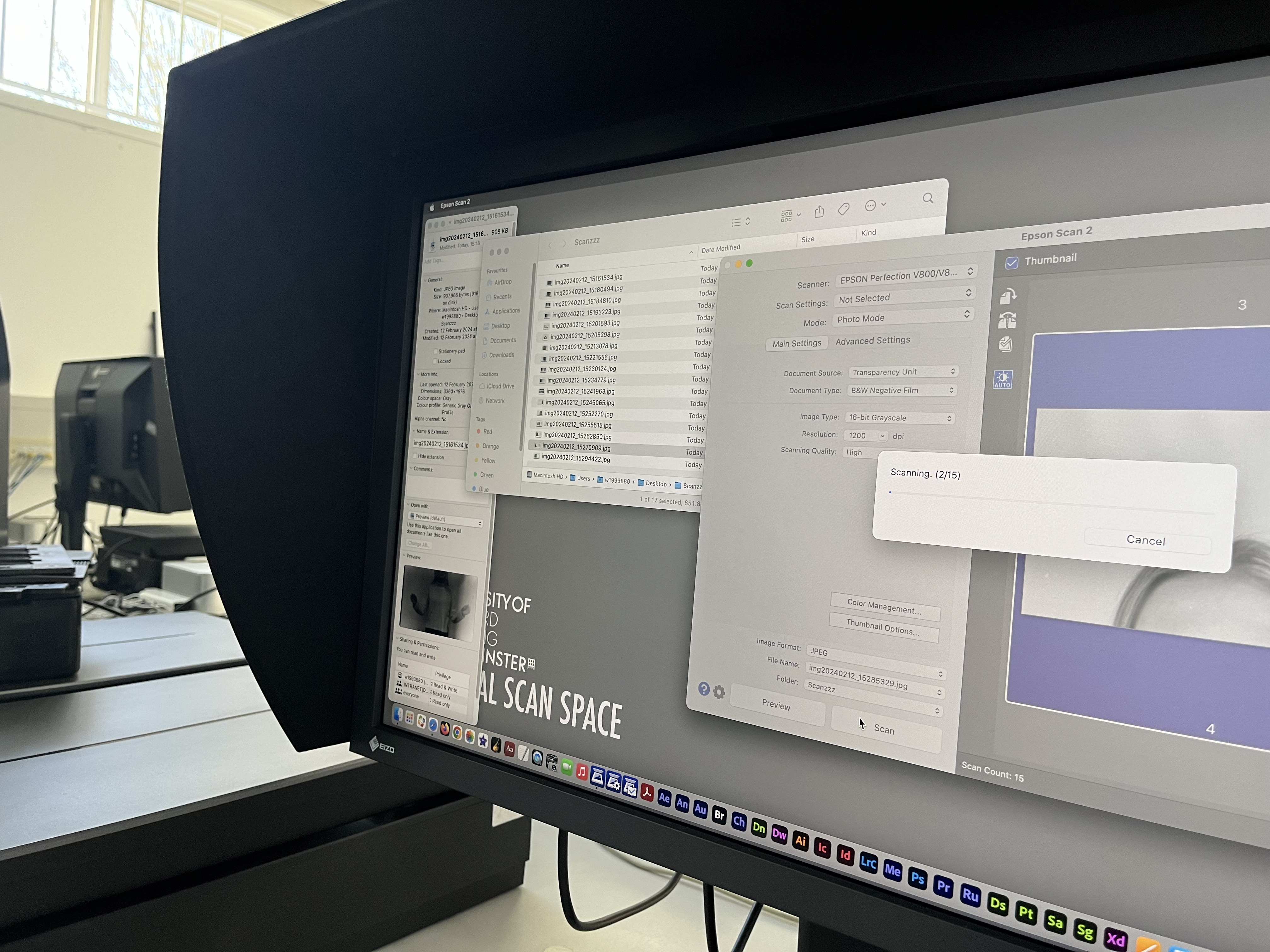
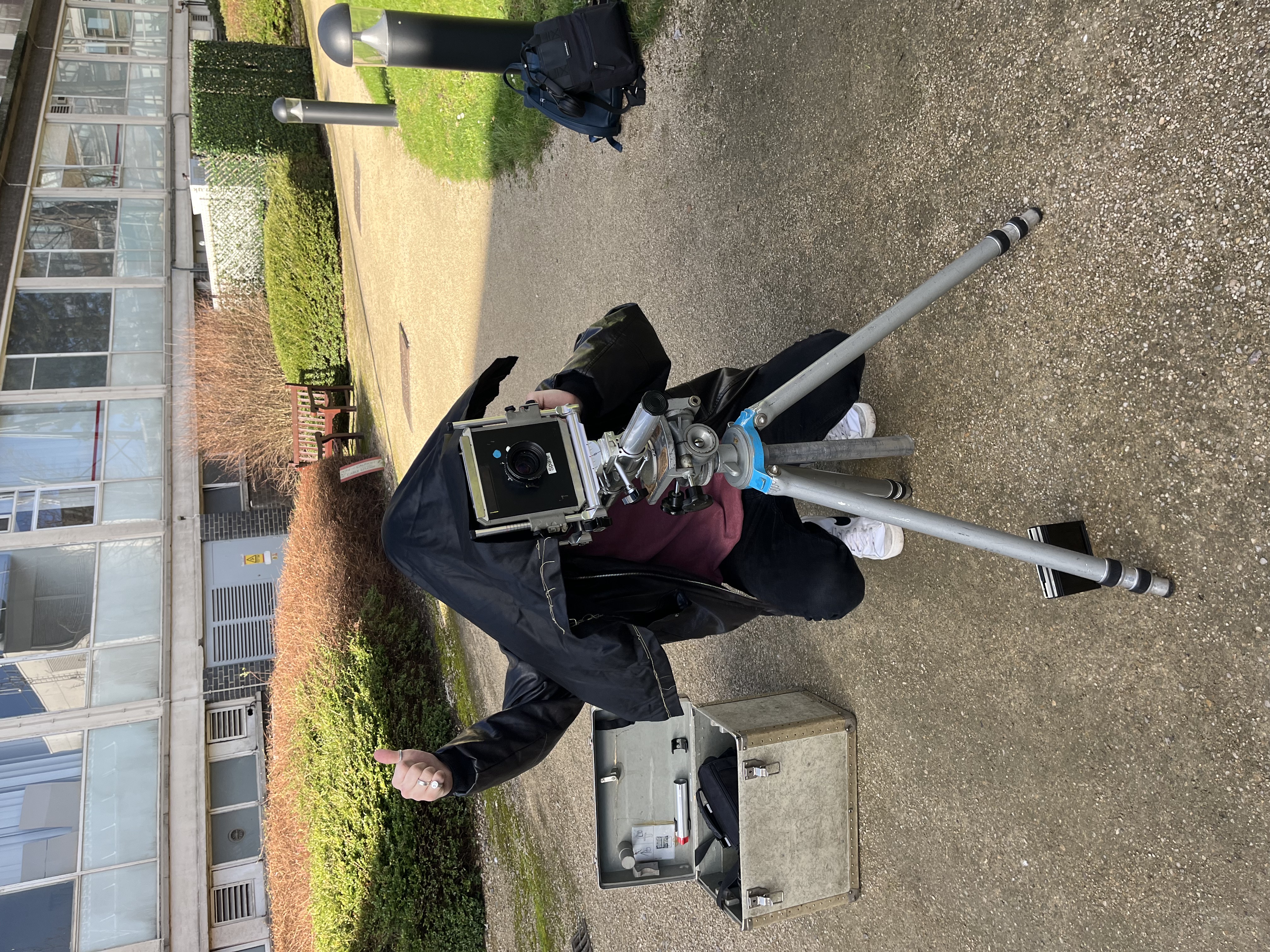


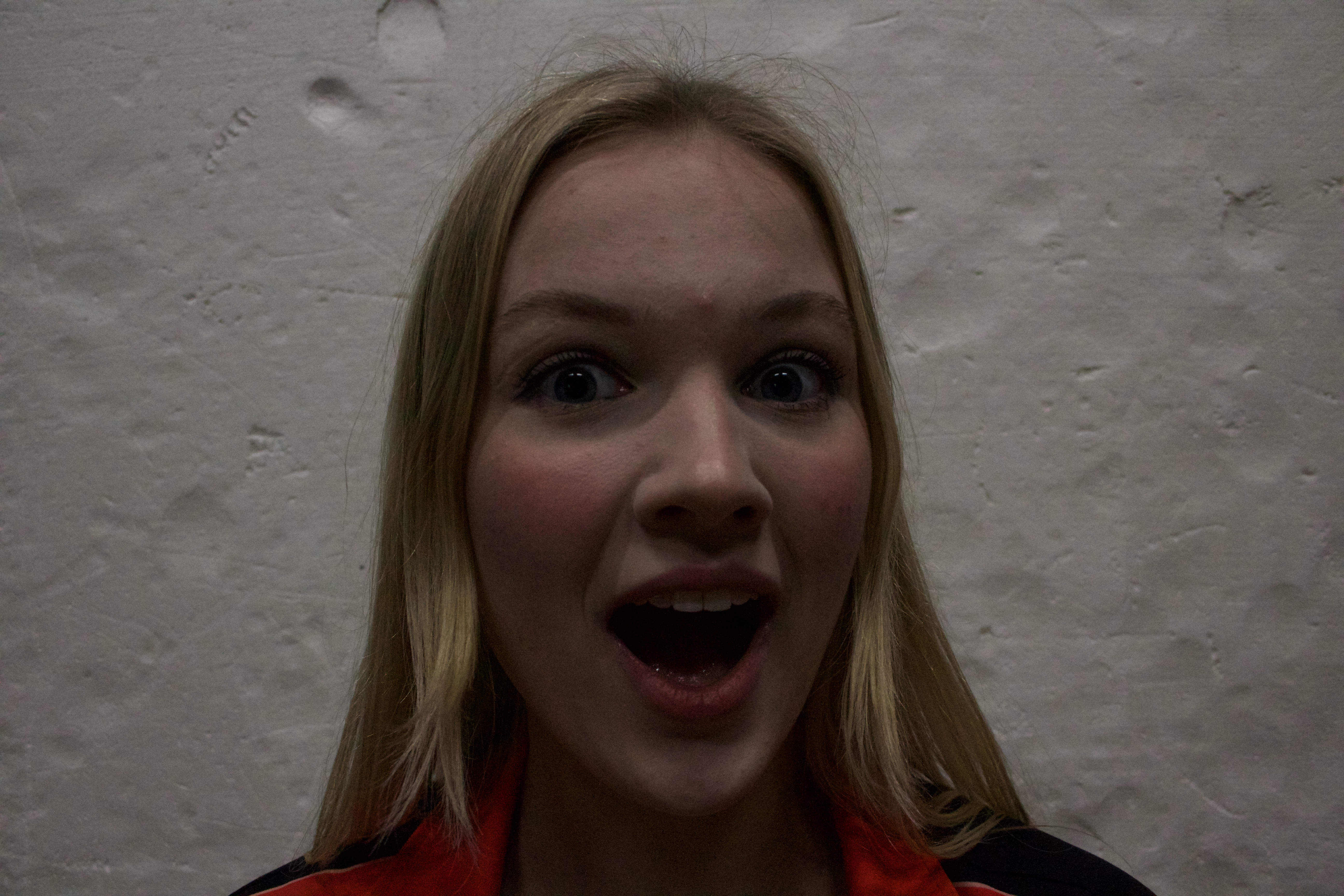
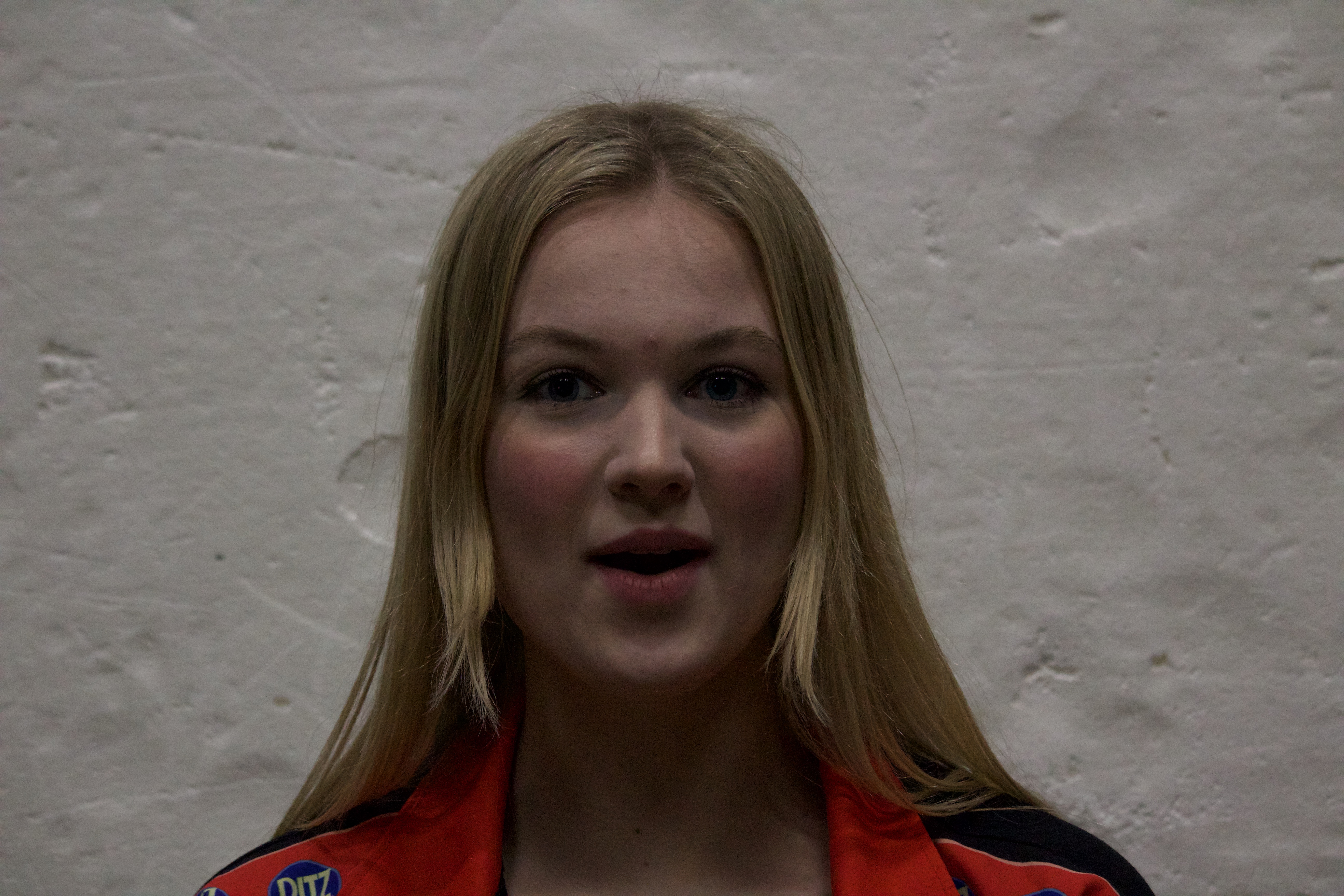

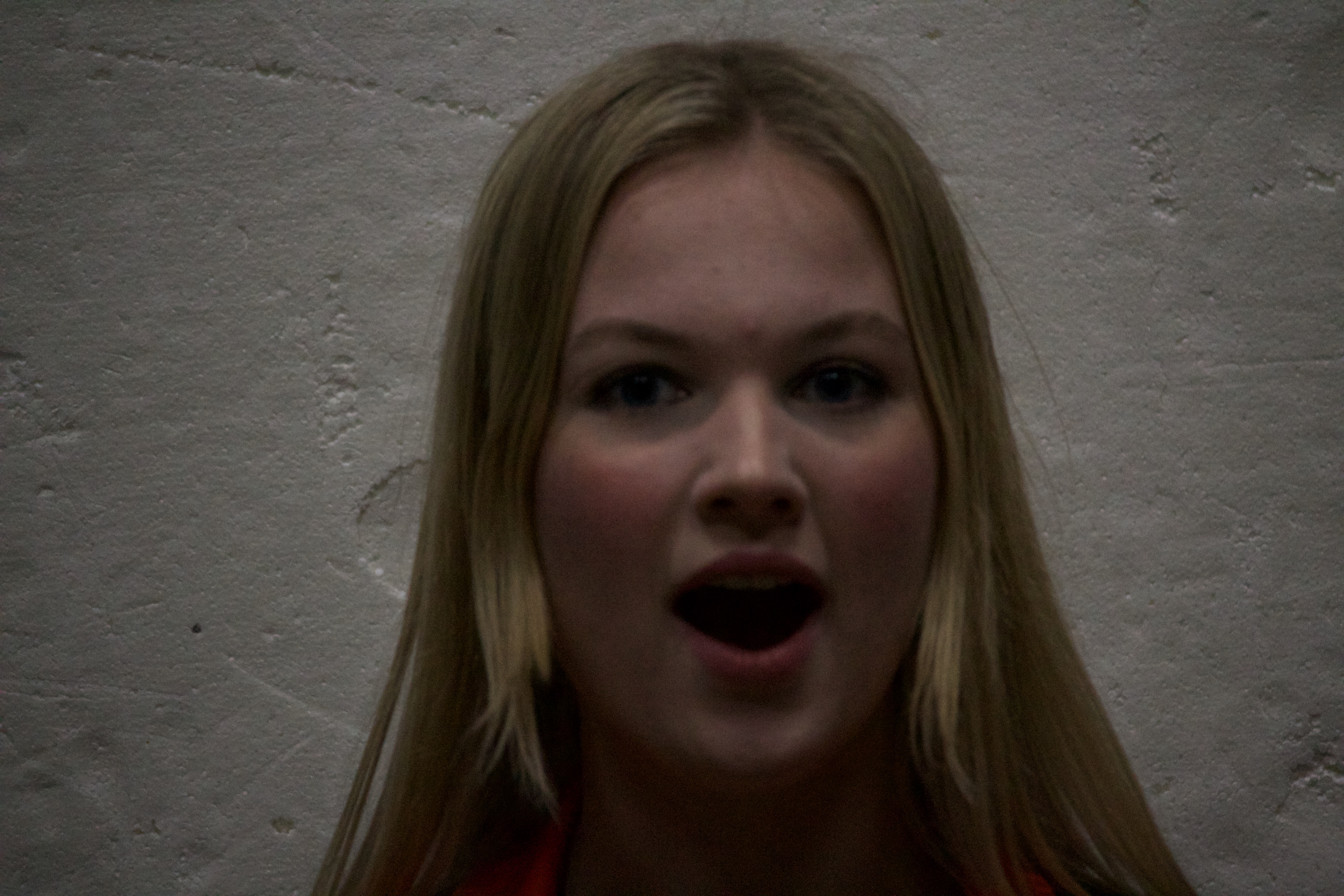

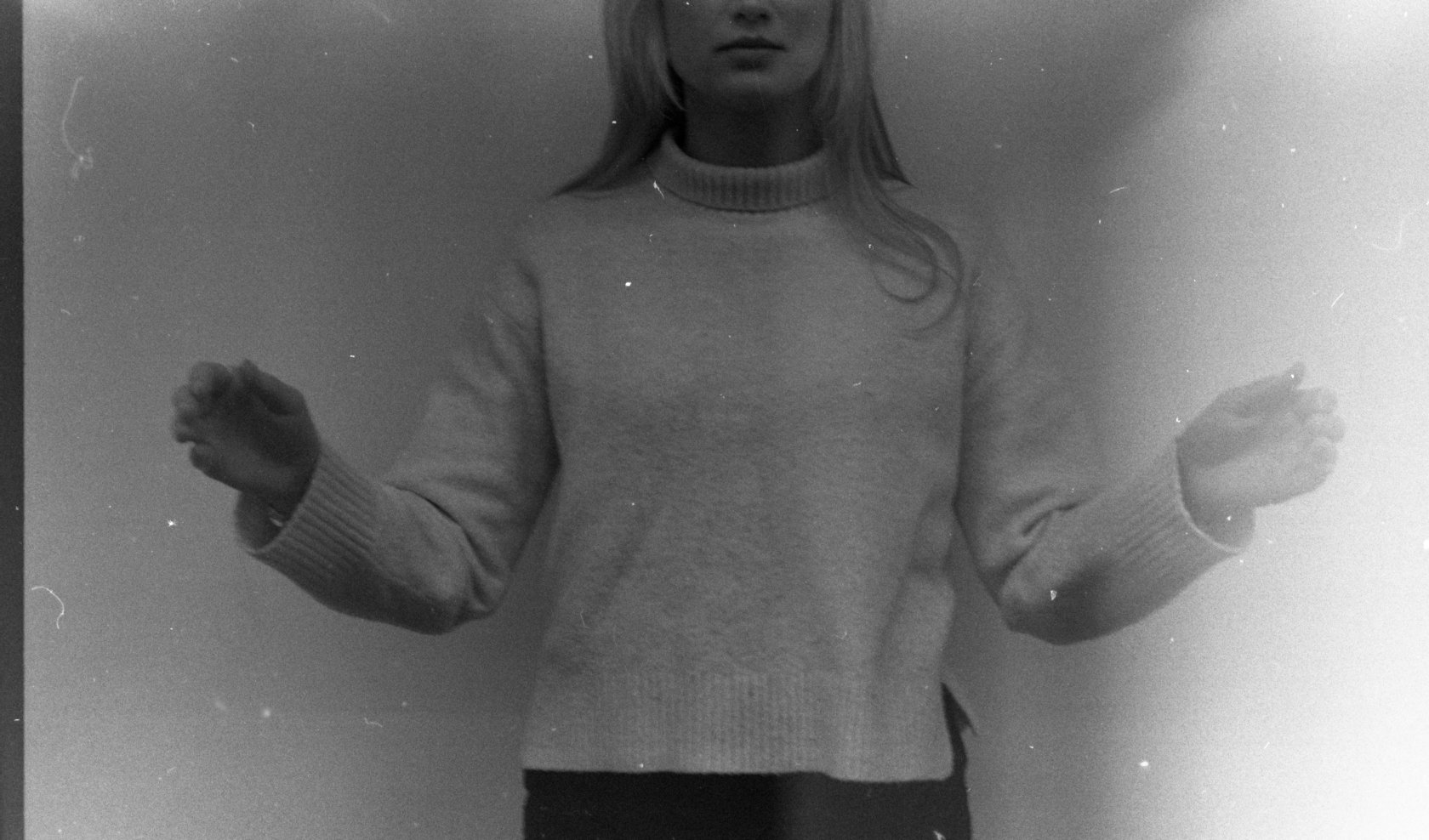

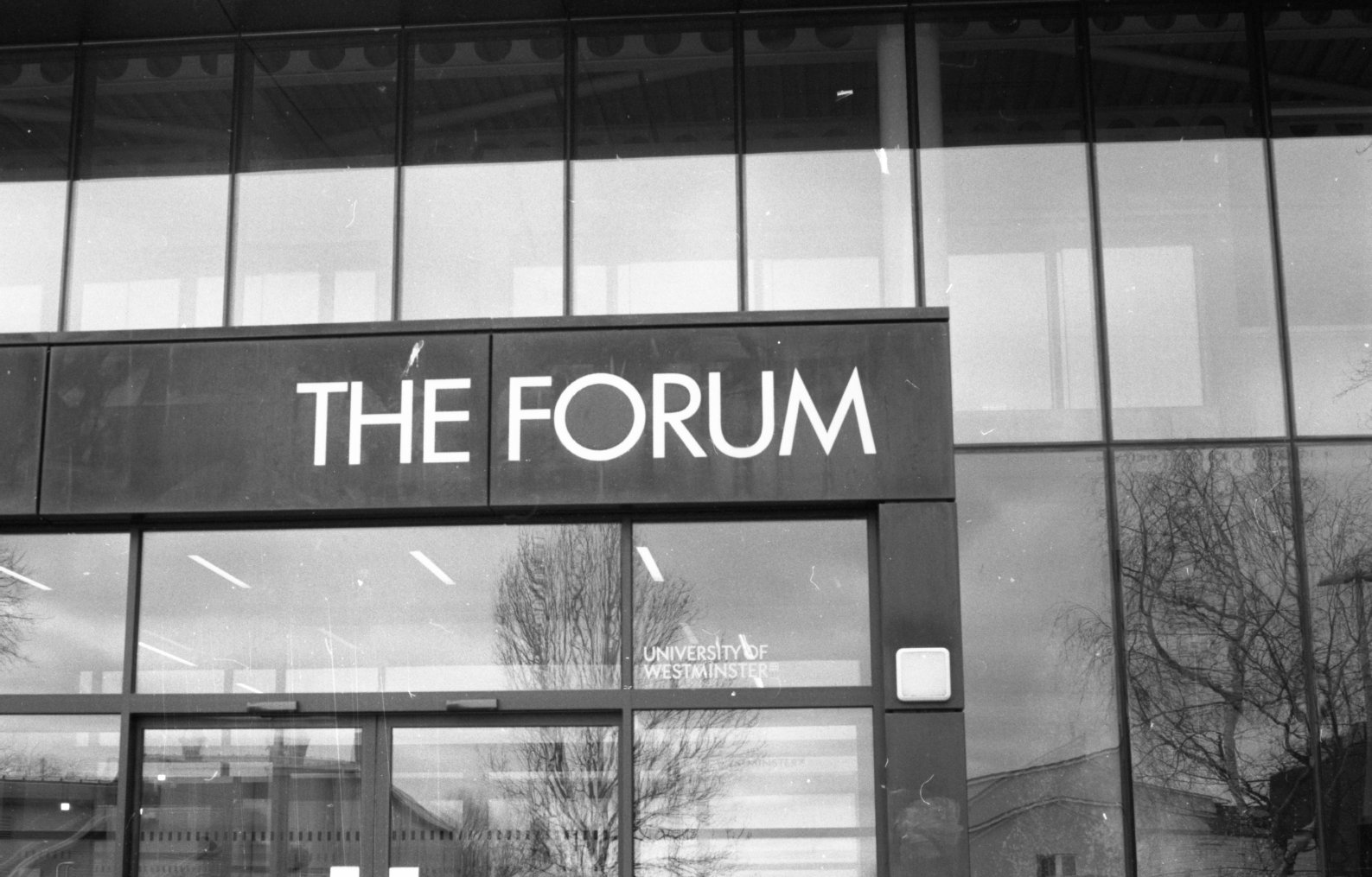
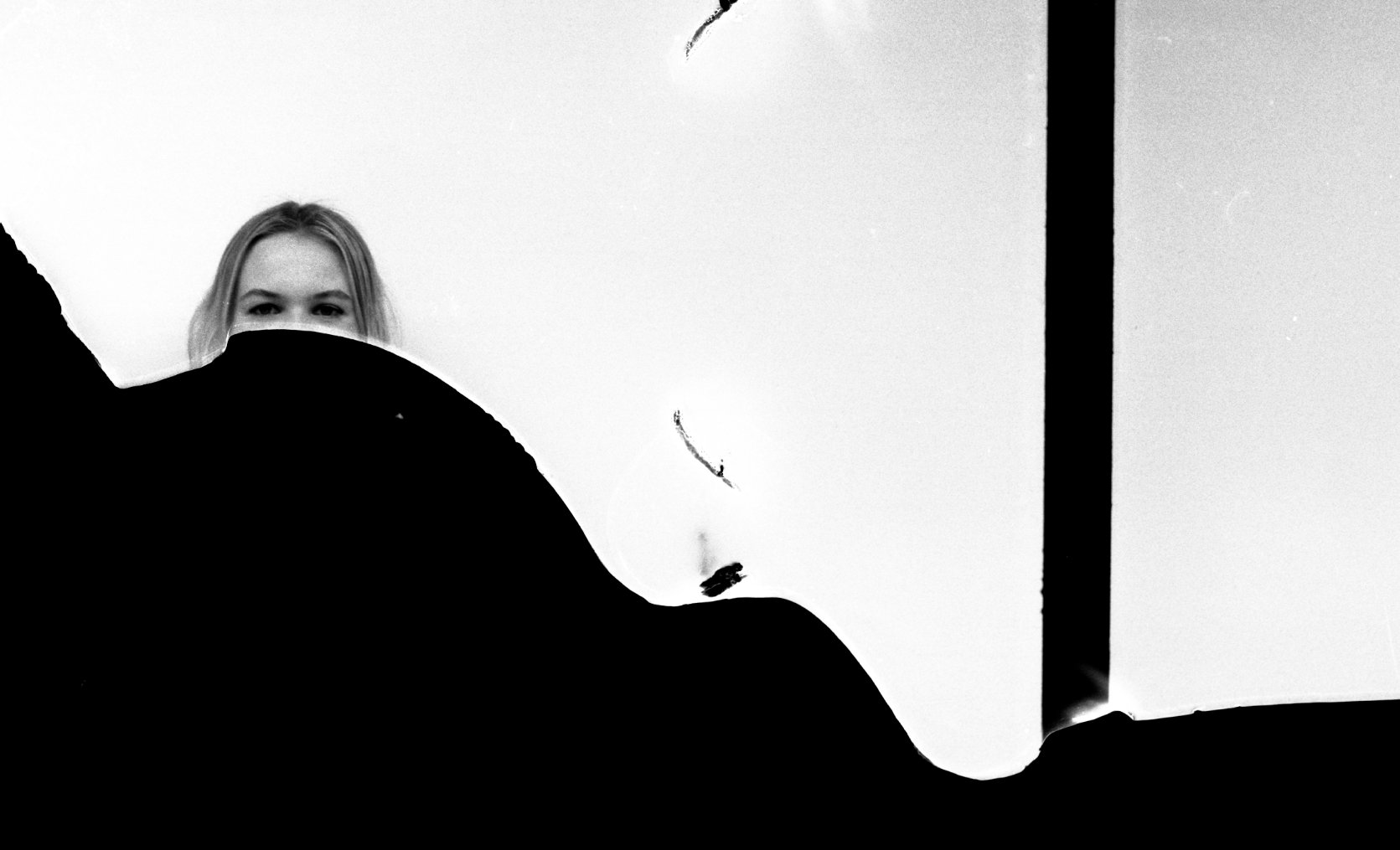
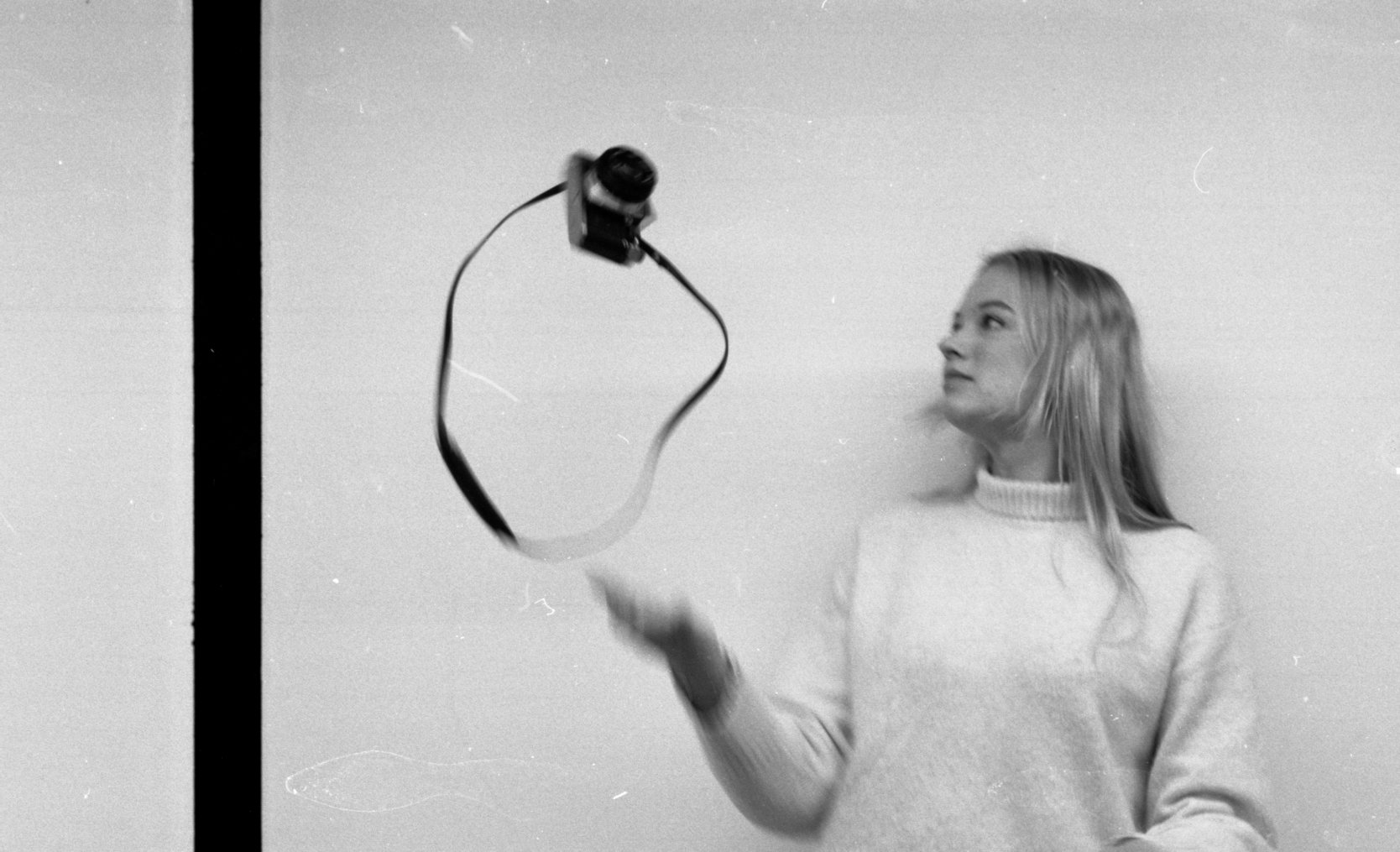

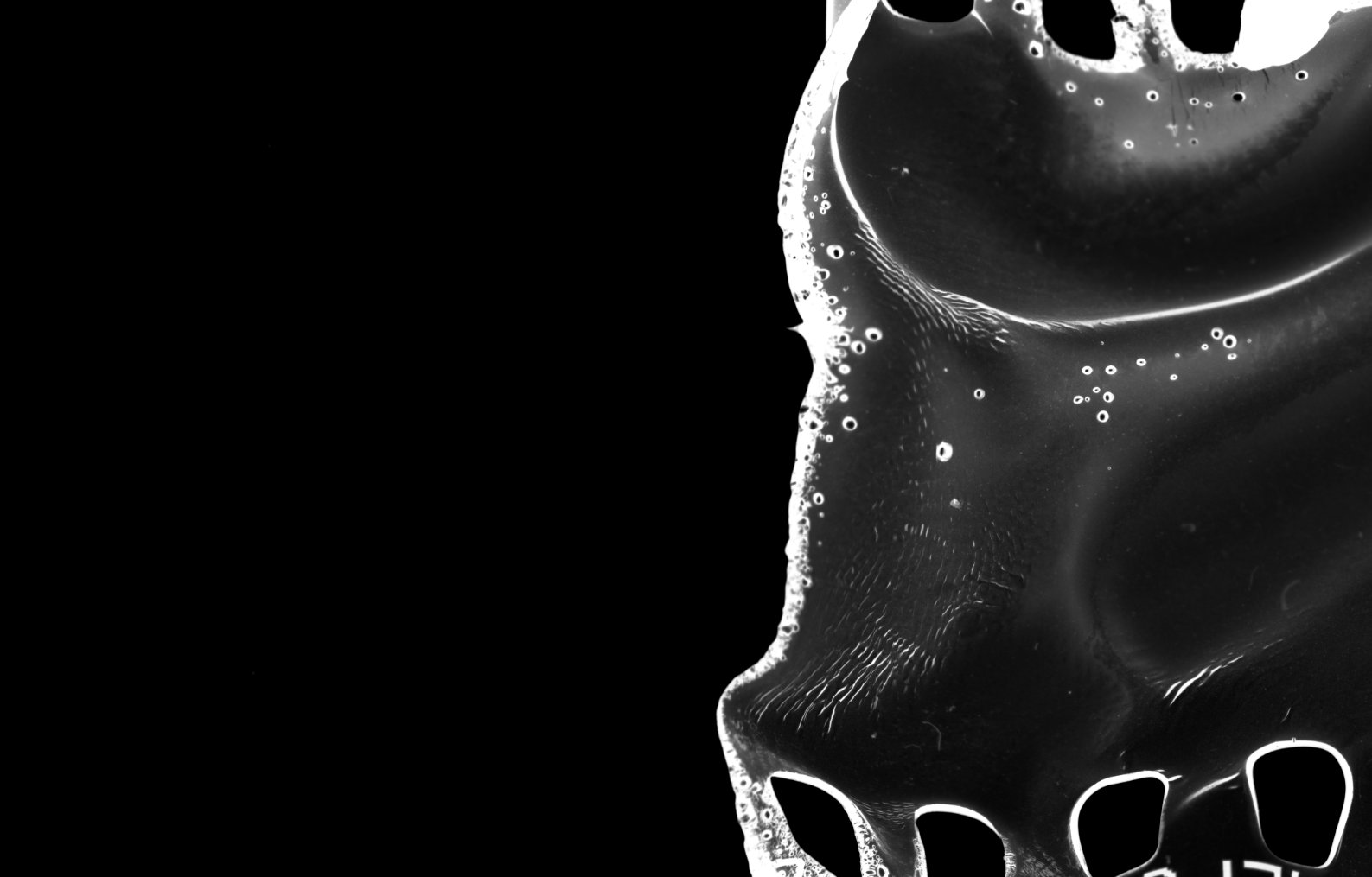
20/02/2024
Research and Reflection
This week I also did some research about the different media elements I may want to use in my piece such as film photography, videography and animation and thought about how I should go about using these in my project. Although the animation may take some time, I would still really like to do some as it is something I am passionate about and want to learn more, as well as utilise some film videography which I will get to practice in a few weeks' time.
This week I learnt how to use a large format camera and process/scan images from film. I learnt how a lens can affect the look of an image and how I can manipulate this for my own gain.
For next week, I need to continue to experiment with photography and videography so that I am better prepared for shooting my project.
This week I learnt how to use a large format camera and process/scan images from film. I learnt how a lens can affect the look of an image and how I can manipulate this for my own gain.
For next week, I need to continue to experiment with photography and videography so that I am better prepared for shooting my project.
19/02/2024
Transformation of Time and
Motion
During today’s lecture, we had a look at a few artists who used photography in different ways to create animations and interesting images. These included the zootrope and light painting that we then tried out in the Blue Shed. We utilised a long shutter speed and moved the light around in front of the camera to create the effect. We also took a stool and utilised a short shutter speed and flash to capture its destruction when we threw it on the ground. I then joined the microscope session and learnt how to take micro shots of specimens. During this time, myself and Noah played around with the website Rokoko which I would like to continue to use, perhaps even for my project. After the practice, we went back to J1.14 to have a look at everyone’s projects and it was very interesting to see what everyone had produced from short animations to beautiful light painting. I am really looking forward to what everyone has to show at the end of the module. We also looked at ‘Man Sized Wreath’ by REM which was really interesting with the varying mediums over the music and I would like to take some inspiration here. I am going to continue to practice with different mediums such as video, audio and 3D rendering and will take out a book to read over the week.
![]()
![]()
![]()
![]()
![]()
![]()
![]()
![]()
![]()
![]()
![]()
![]()
![]()
23/02/2024
‘Midnight on the Metropolitan Line’ and ‘The Glitch Test’
Throughout this week, I have spent time on a project called ‘Midnight on the Metropolitan Line’ which is a film about my journey on the tube back home. I took several videos on the train on my phone and later stitched them together on Premiere Pro and added a voice over of my thoughts and feelings whilst on the journey. I decided to do this project as I was interested in ‘in-the-moment' content and thought I could create something which not only improves my video editing and sound editing skills, but also relates to the theme of memory in a way as it is a memory of the past.
I then went out to capture some night scenes around my accommodation, playing around with the ISO to create very grainy and grungy pictures which fit the memory-like aesthetic. I was inspired by glitch artists such as Daniel Temkin, Rosa Menkman and Nick Briz to explore databending. This included opening an image in a different software, such as Adobe Audition or NotePad, and changing the code to create a glitched image. I then used the images to create a series for another project called ‘The Glitch Test’, simply exploring this concept. I may also want to use this technique for my project as it relates to the disintegration of memory in photography.
![]()
![]()
![]()
![]()
![]()
![]()
![]()
![]()
‘Materialist Film’ by Peter Gidal
This week, I read ‘Materialist Film’ by Peter Gidal. Although he speaks about how film is produced, with its materials and equipment, he mostly talks about how politics affect the making of films. With Capitalism and Consumerism today, there is no doubt that the film industry has used this as bread and butter in order to provide entertainment to the masses. The problem here is that it depicts the directors’ own political stance oftentimes and can cause radicalisation. Gidal argues that there is no suc thing as a universal film experience as we all have our own views and no matter how impersonal the production is, there is still a bias being shown on screen. He talks a lot about gender and the differences between male and female and how this is changing with modern feminism but also how these roles are crucial to society.
Below are some of his quotes and notes I've made:
‘there is a direct analog between the represented film-time and the time for the viewer’ pg1
‘For the British, a radical negativity resulted nevertheless, for the Americans, an idealist positivity’ pg3- Interesting how he is talking about the difference in culture given the continuous debate today.
‘The contradictory histories of subjectivity within materialist aesthetic must occur without the reactionary existential, expressionist and neo-expressionist, romantic and neo-romantic, politic.’ pg9- Here he is talking about how politics mustn’t affect a piece of experimental work as it goes against all that what that work stands for. It is made to be expressive of all, not bound by a specific political stance.
‘The social discourse of experimental cinema is instituted in this way, against the individualist discourse of the sometimes seemingly more social existence of dominant cinema’ pg11- Experimental cinema goes against dominant cinema, causing society to favour the latter since it is more social and widely available.
‘” Attacking sexuality... is in the end attacking the assumption that men and women are complementary somehow, at some basic level’” quoting Christine Delphy pg12-13- Given the now accepted other identities other than male and female today, this is a very interesting point. Identity is extremely important today.
‘”when we use the word ‘women’ and we don’t agree with the category ‘women’” pg13- It is interesting as we seem to be erasing ‘men’ and ‘women today to create a fairer world but we are also obsessed with creating boxes, and sometimes we can’t agree what exactly a ‘woman’ is.
‘The duration of that ‘image’, and that image’s transformation, always preceded by other images, always affecting other images, and their meanings and uses, is inseparable from the material-physical support’ pg16- Images are seen in different ways, depending on the context, so the material used it very important in reading said image.
‘it is not a matter of ‘non-manipulative’ cinema, but of an awareness of its manipulations in-process' pg20- We must be aware of how video is constructed even before it’s construction, during its inception.
‘expressionism, neo-or otherwise, inculcates the imaginary self-identifications that materialism radically struggles against through its (historical) dialectic, the latter in terms of both the spectator's sexual and economic objectivity and, not always separable, individual subjectivities.’ pg 36- He is saying that expressionist film is more personal to the producer, whereas the materialist viewer may have a different experience to that what was intended because of their own values.
‘Many of the filmmakers, not coincidentally, are literary critics manque, and vice versa (often two manqué residing in one body)’ pg41- He makes a good point here about critics only criticising the story without taking into consideration the medium with which it is told. Today, critics are more niche and so a film critic should recognise the motion aspects as well as the story and how they intertwine.
‘Once the class ‘men’ disappears, ‘women’ as a class will disappear as well, for there are no slaves without masters’ pg42- While Gidal may seem a bit sexist here, likening women to slaves, it is interesting how he then talks about feminism and what t is to be a woman. He says it is inevitable and cannot be erased while oppression seems to be built on social constructs of sex.
‘”the widespread theoretical schizophrenia of the left on the subject of women’s oppression. The contradictory analyses they produce are due to a desperate desire to continue to exempt men from responsibility of the oppression of women... men as a class which oppresses and exploits women.’” quoting Monique Plaza in ‘Phallomorphic Power and the Psychology of Women’ pg 43- This is a very interesting stance on the left as an ideology but I’m not sure I can agree with it, especially today, where most people accept that men have oppressed women in the past regardless of your political stance.
26/02/2024
Final Cut Pro Workshop
Today, I attended the Final Cut Pro workshop for still images and learnt how to use the software. I have never used Final Cut Pro before so it was very useful to learn how to use it and that it is best for art-based media, such as stills, rather than video, which is what Premiere Pro is primarily used for. I learnt how to make an animation with an image sequence and then how to edit photos to move within the frame. I then used these skills to make a silly animation with some images I found from the internet.
Transformation of Time and
Motion
During today’s lecture, we had a look at a few artists who used photography in different ways to create animations and interesting images. These included the zootrope and light painting that we then tried out in the Blue Shed. We utilised a long shutter speed and moved the light around in front of the camera to create the effect. We also took a stool and utilised a short shutter speed and flash to capture its destruction when we threw it on the ground. I then joined the microscope session and learnt how to take micro shots of specimens. During this time, myself and Noah played around with the website Rokoko which I would like to continue to use, perhaps even for my project. After the practice, we went back to J1.14 to have a look at everyone’s projects and it was very interesting to see what everyone had produced from short animations to beautiful light painting. I am really looking forward to what everyone has to show at the end of the module. We also looked at ‘Man Sized Wreath’ by REM which was really interesting with the varying mediums over the music and I would like to take some inspiration here. I am going to continue to practice with different mediums such as video, audio and 3D rendering and will take out a book to read over the week.



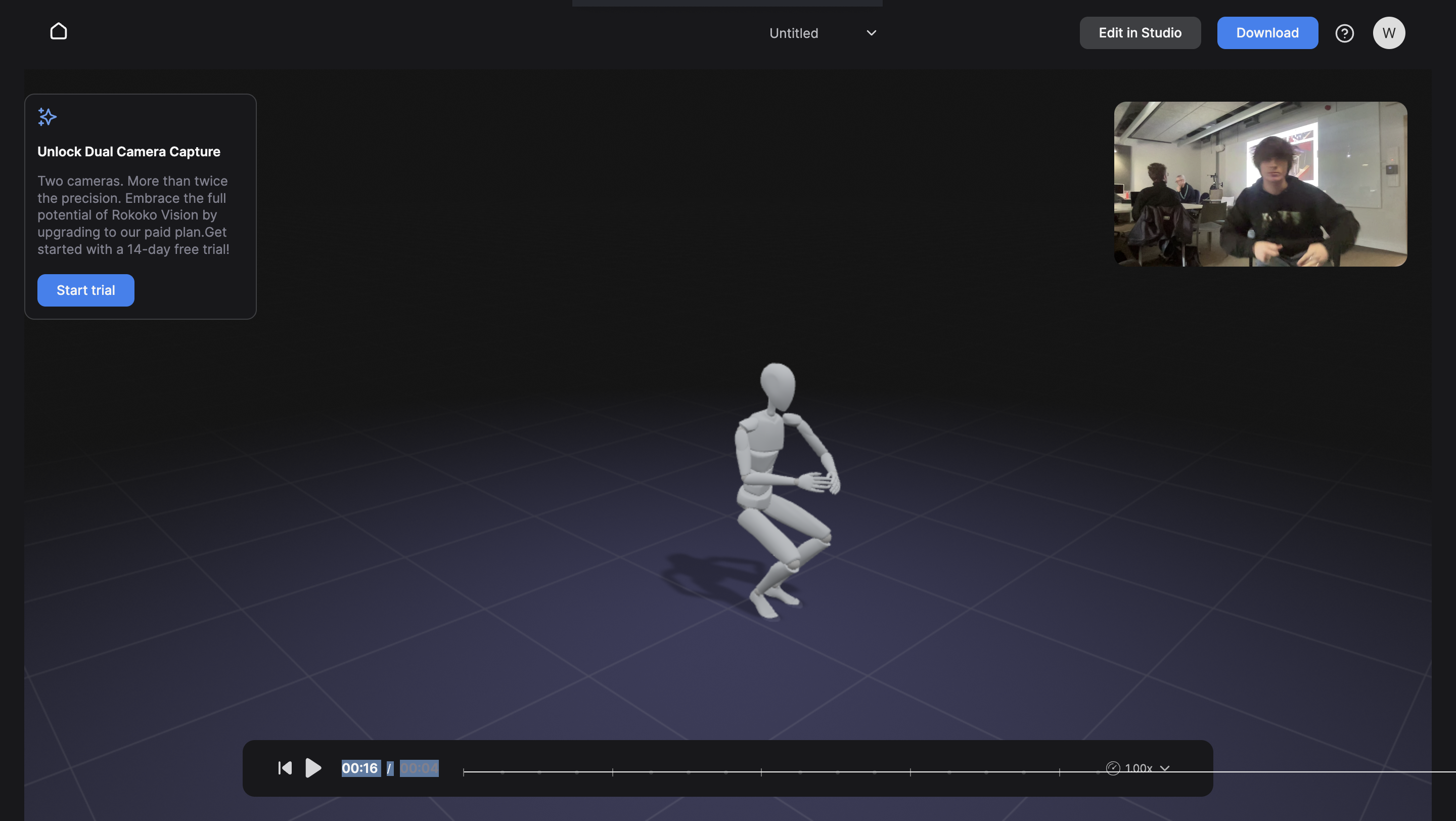
23/02/2024
‘Midnight on the Metropolitan Line’ and ‘The Glitch Test’
Throughout this week, I have spent time on a project called ‘Midnight on the Metropolitan Line’ which is a film about my journey on the tube back home. I took several videos on the train on my phone and later stitched them together on Premiere Pro and added a voice over of my thoughts and feelings whilst on the journey. I decided to do this project as I was interested in ‘in-the-moment' content and thought I could create something which not only improves my video editing and sound editing skills, but also relates to the theme of memory in a way as it is a memory of the past.
I then went out to capture some night scenes around my accommodation, playing around with the ISO to create very grainy and grungy pictures which fit the memory-like aesthetic. I was inspired by glitch artists such as Daniel Temkin, Rosa Menkman and Nick Briz to explore databending. This included opening an image in a different software, such as Adobe Audition or NotePad, and changing the code to create a glitched image. I then used the images to create a series for another project called ‘The Glitch Test’, simply exploring this concept. I may also want to use this technique for my project as it relates to the disintegration of memory in photography.


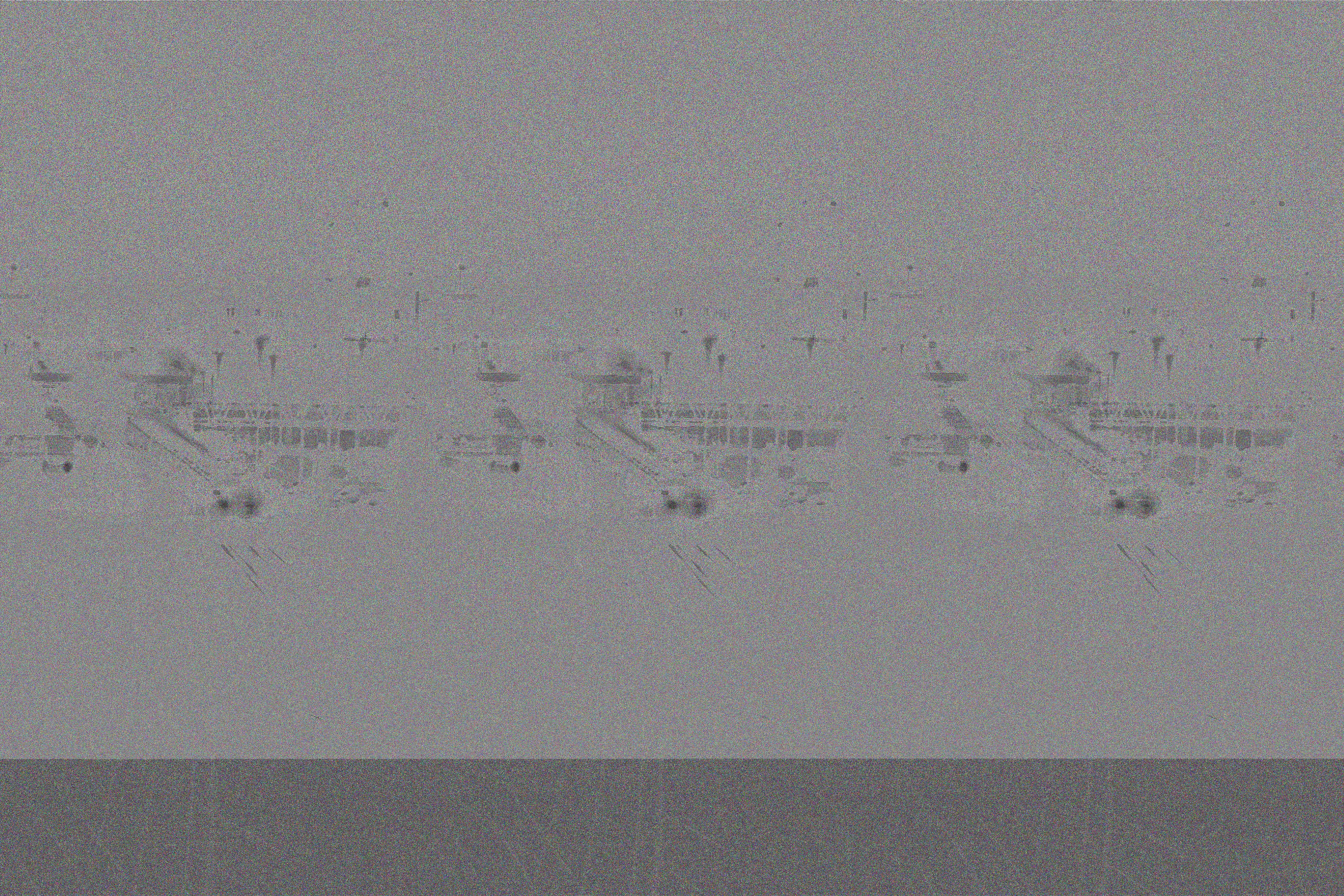

‘Materialist Film’ by Peter Gidal
This week, I read ‘Materialist Film’ by Peter Gidal. Although he speaks about how film is produced, with its materials and equipment, he mostly talks about how politics affect the making of films. With Capitalism and Consumerism today, there is no doubt that the film industry has used this as bread and butter in order to provide entertainment to the masses. The problem here is that it depicts the directors’ own political stance oftentimes and can cause radicalisation. Gidal argues that there is no suc thing as a universal film experience as we all have our own views and no matter how impersonal the production is, there is still a bias being shown on screen. He talks a lot about gender and the differences between male and female and how this is changing with modern feminism but also how these roles are crucial to society.
Below are some of his quotes and notes I've made:
‘there is a direct analog between the represented film-time and the time for the viewer’ pg1
‘For the British, a radical negativity resulted nevertheless, for the Americans, an idealist positivity’ pg3- Interesting how he is talking about the difference in culture given the continuous debate today.
‘The contradictory histories of subjectivity within materialist aesthetic must occur without the reactionary existential, expressionist and neo-expressionist, romantic and neo-romantic, politic.’ pg9- Here he is talking about how politics mustn’t affect a piece of experimental work as it goes against all that what that work stands for. It is made to be expressive of all, not bound by a specific political stance.
‘The social discourse of experimental cinema is instituted in this way, against the individualist discourse of the sometimes seemingly more social existence of dominant cinema’ pg11- Experimental cinema goes against dominant cinema, causing society to favour the latter since it is more social and widely available.
‘” Attacking sexuality... is in the end attacking the assumption that men and women are complementary somehow, at some basic level’” quoting Christine Delphy pg12-13- Given the now accepted other identities other than male and female today, this is a very interesting point. Identity is extremely important today.
‘”when we use the word ‘women’ and we don’t agree with the category ‘women’” pg13- It is interesting as we seem to be erasing ‘men’ and ‘women today to create a fairer world but we are also obsessed with creating boxes, and sometimes we can’t agree what exactly a ‘woman’ is.
‘The duration of that ‘image’, and that image’s transformation, always preceded by other images, always affecting other images, and their meanings and uses, is inseparable from the material-physical support’ pg16- Images are seen in different ways, depending on the context, so the material used it very important in reading said image.
‘it is not a matter of ‘non-manipulative’ cinema, but of an awareness of its manipulations in-process' pg20- We must be aware of how video is constructed even before it’s construction, during its inception.
‘expressionism, neo-or otherwise, inculcates the imaginary self-identifications that materialism radically struggles against through its (historical) dialectic, the latter in terms of both the spectator's sexual and economic objectivity and, not always separable, individual subjectivities.’ pg 36- He is saying that expressionist film is more personal to the producer, whereas the materialist viewer may have a different experience to that what was intended because of their own values.
‘Many of the filmmakers, not coincidentally, are literary critics manque, and vice versa (often two manqué residing in one body)’ pg41- He makes a good point here about critics only criticising the story without taking into consideration the medium with which it is told. Today, critics are more niche and so a film critic should recognise the motion aspects as well as the story and how they intertwine.
‘Once the class ‘men’ disappears, ‘women’ as a class will disappear as well, for there are no slaves without masters’ pg42- While Gidal may seem a bit sexist here, likening women to slaves, it is interesting how he then talks about feminism and what t is to be a woman. He says it is inevitable and cannot be erased while oppression seems to be built on social constructs of sex.
‘”the widespread theoretical schizophrenia of the left on the subject of women’s oppression. The contradictory analyses they produce are due to a desperate desire to continue to exempt men from responsibility of the oppression of women... men as a class which oppresses and exploits women.’” quoting Monique Plaza in ‘Phallomorphic Power and the Psychology of Women’ pg 43- This is a very interesting stance on the left as an ideology but I’m not sure I can agree with it, especially today, where most people accept that men have oppressed women in the past regardless of your political stance.
26/02/2024
Final Cut Pro Workshop
Today, I attended the Final Cut Pro workshop for still images and learnt how to use the software. I have never used Final Cut Pro before so it was very useful to learn how to use it and that it is best for art-based media, such as stills, rather than video, which is what Premiere Pro is primarily used for. I learnt how to make an animation with an image sequence and then how to edit photos to move within the frame. I then used these skills to make a silly animation with some images I found from the internet.
02/03/2024
‘Cinema, Memory, Modernity’ by Russell J. A. Kilbourn
This week, I read ‘Cinema, Memory, Modernity’ by Russell J. A. Kilbourn which delves into memory in the cinematic sense. Kilbourn discusses how cinema hold memory in a way that is contrived and often edited, not necessarily staying true to the original memory. Memory is not only derived from physical technologies such as photographs and videos, but is also a more personal experience, mentioning trauma and the real trauma of going back to that experience with something like PTSD. Photographs and videos only hold certain information yet the whole event may not have been recorded, therefore the memory can be lost or even replayed in someone’s mind when viewing the physical technology. Many of our memories are triggered by technology but this technology can also give a flase narrative, leading to false memories. He also goes on to talk about how Western media is often plagued by the narrow view of Christianity, failing to represent the ‘other’.
‘This study is able to begin from the assumption that memory today derives its primary meaning, its existence as such, from visually based technologies like cinema; that cinema is not merely one of the most effective metaphors for memory but that cinema- alongside photography- is constitutive of memory in its deepest and most meaningful sense’ pg1
‘For Aristotle, in other words, memory is not part of thinking (conception) but rather part of the basis for thought, as an aspect of self-perception. A strong sense perception leaves a palpable impression or ‘image’ on the soul of the recipient; this literal image in turn occasions an ‘affection’ or emotion or ‘movement’ in the soul which is the direct cause of the memory (the process of recollection)’ pg 5 after quoting ‘De Memoria et Reminiscentia’ (ca. 350 BCE, 29-30)
‘cinematic memory’ in this sense at best supplements and at worst destroys ‘natural’, human memory by naturalising the technical and artificial, providing a seemingly ‘universal’ objective visual language for the representation of the subjective (re-) experience of the past’ pg 6
‘in terms elaborated here, modern memory, whether individual or collective, is by definition ‘exterior’, hypernmesic, hence archival’ pg 20
‘A photograph, therefore, is in this sense like a finger- or footprint, left behind at the scene of a crime, indices or traces heralding the actual presence of someone who was there and is now passed on’ pg 59
‘memory signifies here on the collective-cultural level [...] as ‘History’, on the one hand (the diegesis), and as cinematic intertextuality, or the other (visual style)’ pg 105
‘’trauma’ is not in the original event or experience but in the re-experiencing, via memory: it is memory that is traumatic, not the original experienceper se’ pg 133
‘In modern culture the ‘fetish’ mystifies the relation between the object or referent and its representation or sign; in post-modern terms the fetish mystifies the relation between signifier and signified’ pg 166
‘How we think about ourselvestoday literally coincides with how we see ourselves; how we represent ourselves to ourselves and to others, but also how and to others, but also how ‘we’ represent- or fail to represent- the other’ pg 179
Personal Research
During some research for music for my piece, I came across an AI music generator which generated fairly well made songs. I was impressed by its intelligence and ability to simply generate music easily. If I am unable to find a composer for my piece or make something myself. It may be worth looking into this website and finding a track that fits my theme, then writing my own lyrics, which I feel I can do. https://soundraw.io
I also spoke to my mum about my project and she gave me some good examples of music videos I may want to check out. These included ‘New Order’ by Blue Monday https://www.youtube.com/watch?v=c1GxjzHm5us and ‘Acceptable in the 80’s’ by Calvin Harris https://www.youtube.com/watch?v=dOV5WXISM24 The visuals in ‘Blue Monday’ have inspired me to do a similar thing with scan animations to create that feel and style of video. ‘Acceptable in the 80’s’ focuses on the 80’s style and has visuals and music beats related to that time period as an ode to the 80’s. Similarly, I’d like to use this concept and utilise music from different decades to relate back to that time in my video.
This week I learnt how to use still images in a sequence to make an animation and how software can be used in different ways to animate pictures. This is particularly useful as I will use this knowledge in my piece to animate pictures taken on a film camera.
For next week, I need to prepare to explain my ideas to John and continue to look for a suitable song which I can use for this piece.
04/03/2024
Project Proposal Feedback
During my tutorial with John, we went through my project proposal and he mentioned talking to Liz as she is a music student. His main question was about whether I had the ability to do such as challenging project but I am hopeful that I can try my best at creating something well-done and creative. I think I have the experience to try to make something interesting and will continue to search for ways I can write or at least perform a song. This week, I will continue to look into AI music and once I have a song, I will write the lyrics and sing a demo version in order to start making some of the visuals for it.
10/03/2024
‘An Outline of Psychoanalysis’ by Sigmund Freud
This week I read Sigmund Freud’s ‘An Outline of Psychoanalysis’ in response to the previous texts I have read which often quote Freud in relation to film and photography. While he opens every chapter with the somewhat friendly, ‘Ladies and Gentlemen!’, much of his writing is in a less formal tone yet describe concepts that are often misunderstood. He first talks about dream theory and whether dreams hold any meaning, referring to memories and the act of forgetting. While this is interesting, this may not relate back to my subject as I am not focusing on dreams here. He talks about how dreams are inherently sexual and seems quite focused on that fact to say that he discourages anyone who discourages himself, saying ‘this sort of derivation tends to reap the anger of all those researchers who are not psychoanalytically inclined’ pg20. He goes on to mention the ‘Ich’ or (evil) desire in people or our conscience and the ‘Uber-ich’, that very strong desire. This is not particularly relevant but it is interesting how he objectifies our desires in this way. In the section ‘Fear and Drives’, Freud goes on to talk about how the first fear was being born and thus from this experience, we gain apprehensiveness. He relates fear to the libido; somewhat of an unpopular stance here. He mentions that boys fear being castrated while girls fear losing love... Again, this is not relevant to my studies but I can’t say that I truly believe all he is saying without seeing any studies he has conducted. In the section ‘femaleness’, Freud talks about how the male and female psychology is different and that during puberty, both sexes experience different things as they grow towards adulthood. With relation to the Oedipus complex, he explains how children are innately ‘bisexual’ and come into their sexuality. This is really important to read, as, while I disagree with a lot of what he says, the question of homosexuals and trans people are not mentioned, which leaves a large gap in his theory when relating childhood to libido and sexual stages. Freud then goes on to talk about the differences in psychoanalysis, science and religion, arguing that religions stunts scientific research and reassuring the reader that psychoanalysis is extremely important and should be studied. Mentioning how religion opposes these views while being respectful to those who follow it is very interesting as it can certainly be said that today, we can be both scientific and religious without too much backlash. Both parties are trying to find the ‘truth’ but in very different ways so it may be beneficial to combine forces in order to move forward as peoples. Overall, while this was a very interesting read, Freud’s theories are not necessarily directly related to my project. Having said that, I may want to include some of his ideas regarding sexuality and politics of science in my piece where possible as these are very interesting topics which paint the world as it is today.
‘all dreams are sexual in nature’ pg4
‘every dream includes a memory-trace of or allusion to one or, frequently, several of the previous day’s events’ pg7
‘preconscious- thinking; they could also have been thought in the waking life, indeed were probably formed over the course of the day’ pg14
‘I feel inclined to do something which would give me pleasure, but I refrain from doing it on the grounds that my conscious forbids it’ pg55
‘What people fear is evidently their own libido’ pg77
‘What is unquestionably ‘male’ is the male sexual product, the spermatozoon, and its vehicle; what is unquestionably ‘female’ is the egg and the orgasm that harbours it’ pg103
‘if you say ‘male’, then you usually mean ‘active’, and if you say ‘female’, then you usually mean ‘passive’’ pg104 – Despite this apparent sexist statement, he does go one to talk about how the ‘female’ is passive in the sexual sense but is absolutely active when raising a child for example.
‘Women can display great activity in many different directions; men can’t co-exist with their own kind unless they develop a high degree of passive submissiveness’ pg105
‘The sexual fragility of women, which we encounter so often that it seems to confirm this pattern of discrimination, is a phenomenon that is not satisfactorily understood’ pg121
‘If you want to know more about femaleness, you should question your own experiences, or turn to the poets, or wait until science can give you more profound and coherent information’ pg125
‘Except in the case of a few people who are, as we say, ‘possessed’ by art, it doesn’t seem to venture to encroach on the realm of reality’ pg149
Song Writing
This week I practiced writing the music for my piece. I used an AI music generator to write a few different tracks which I may want to use for my piece. This is the generator I used: https://artlist.io/?utm_source=google&utm_medium=cpc&utm_campaign=19561679671&utm_content=145533435815&utm_term=artlist.io&keyword=artlist.io&ad=685857664512&matchtype=e&device=c&gad_source=1&gclid=CjwKCAjw17qvBhBrEiwA1rU9wxHyyrQ0SxZN2tacBTkvTqvkVJqeZjDvNA9zv-po_ReA1MdeN0gNIBoC4OYQAvD_BwE
I also began writing the lyrics to the song:

11/03/2024
Tutorial
Today I had a tutorial with John where I explained where I am at with my project and that I am using AI music to help generate the music for my piece. During the tutorial, John suggested continuing to find a suitable track and that it doesn’t matter if it isn’t the greatest music ever! I need to get started by choosing a song and lyrics and then I am able to begin thinking about my visuals, which I hope to do so this week. I also need to read ‘Speed and Politics’ by Paul Virilio to help with my understanding of accelerationism. I have also taken out ‘An Introduction to Karl Marx’ by Jon Elster and ‘On Film and Radio’ by Bertolt Brecht to help gain an understanding of their works as they are often cited in other literature I have read.
17/03/2024
‘An Introduction to Karl Marx’ by Jon Elster
This week I read ‘An Introduction to Karl Marx’ by Jon Elster which delves into Marx’s key concepts around capitalism, historical materialism, alienation class struggle and communism and their relevance to contemporary, social and political issues. Elster examines Marx’s ideas, offering positives and negatives to the practice throughout while explaining his ideas thoroughly to the reader. He talks about some of Marx’s influences and circumstances for his ideas and how this has then influenced many scholars and people today around socialist, capitalist and governmental ideas. Marxist theory critiques capitalism with these key concepts:
- Historical Materialism: material conditions of society determine the development of human history, economic structure affects social structure
- Dialectal Materialism: opposing historical factors lead to the emergence of new societal structures
- Capitalism and Exploitation: the critique of capitalism as a system characterised by private ownership of the means of production, which then includes exploitation of those workers. He argues that capitalists accrue profit by exploiting their workers
- Class Struggle: There is an evident class divide and capitalism furthers this divide, causing a conflict between the classes, eventually leading to revolution
- Alienation: workers become disconnected to the products they produce and even their own humanity
- Socialism and Communism: Socialism is the middle stage between capitalism and communism, where the means of production are owned collectively therefore the means for profit disappears. Communism is the absolute stateless society where produce is delegated to those in need
- Ideology and Hegemony: Marx analyses ideology as a set of beliefs that legitimise the existing social order, often serving the interests of the upper class. Hegemony is where a dominant group shapes norms, values and institutions of society to retain control
- Critique of Imperialism and Global Capitalism: Capitalist expansion exploits peripheral regions, exacerbates inequalities and perpetuates dependency
This is very interesting to read about and it is important to know what other writers are referring to when they mention Marx. His theory is often used as a parallel to art theory with its placed importance on going against the social norms. However, I find this somewhat contradictory since, while it is possible to make art for art’s sake, most artists go on to sell their work for a profit, therefore continuing the capitalist ideas around money and innovation.
‘Methodical individualism is the view that all institutions, behavioural patterns, and social processes can in principle be explained in terms of individuals only: their actions, properties, and relations’ pg22
‘Society, they argued, begins as a primitive, undifferentiated community. Persons are essentially similar to one another, without distinctive character traits or different productive functions’ pg35 – alienation of an individual then leads to individuality, forcing the individual to leave the community, only for the third stage to be when a group allows individuality within the group
‘The choice of wage labour is forced, although uncoerced’ pg82
When talking about why Ancient Rome did not become a capitalist society, Elster argues ‘that capitalism did not arise because there was no competitive national market’ pg119
‘purely “commercial” or capitalist government would be too myopic or too greedy on behalf of capital, thus undermining its long-term interest’ pg146- when speaking about Walter Bagehot’s ideas around why capitalism doesn’t benefit the bourgeoisie
‘religion is the “opium of the people”, with the statement that religion helps people adapt to their miserable lives’ pg171
‘he proposed an “abdication theory” of the state, according to which the state is allowed to have some autonomy but only because it suits the interest of the capitalists’ pg198
‘On Film and Radio’ by Bertolt Brecht
I also read ‘On Film and Radio’ by Bertolt Brecht which talks about how visual and sound mediums can influence critical engagement and social change. I have previously acted in some of his plays and so it is very interesting to me to see his thoughts of film and radio as opposed to theatre and poetry. Brecht is particularly famous for his ‘Epic Theatre Principles’ which allow the audience to be critical of the art they are being shown. Artists are encourages to use techniques such as defamiliarization to disrupt passive identification with characters and narratives; this can also be done through the art of film and radio. He talks about montage, interruption and direct address to encourage audience participation even in film and other media, this is to form a dialectal relationship between the work and its audience. He mentions some Marxist views too, especially in relation to dialectal materialism, exploring how Marxist thought in media can reveal economic structures of society, highlighting class contradictions, alienation and exploitation. He also critiques the dominant narratives propagated by mainstream media, which often serve the ruling class. He calls for a ‘committed’ art that aligns with the struggle of the working class and challenges ideologies such as capitalism and imperialism. Brecht experiments with formal techniques, drawing inspiration from avant-garde movements such as Soviet montage and German Expressionism. He explores how editing, narrative and sound design can be manipulated to convey social and political messages. He seems to have a willingness to break from traditional norms. Additionally, he includes a few screenplays which demonstrate his political views.
This was a very interesting read as it highlights a different perspective on art in a way that goes against the capitalist regime. But, again like with Marxist theory, Brecht fails to understand the importance of selling art on the free market, which is around because of capitalism, therefore it is very difficult to make art without adding to the ‘problem’.
‘Joyce uses the Verfremdungeffekt in Ulysses. He alienates both the way of representing (mainly through the frequent and rapid changes) and events’ pg10
‘times are good when the production side, far from supplying obsolete, worn-out and apathetic theatres, decides to eliminate this kind of theatre’ pg33- the ‘kind of theatre’ he is referring to here is ‘ones unsuitable for their plays’.
‘No snob doubts that artistic experiment is dead’ pg146
‘These people felt that, by agreeing to deal with the film industry, we put ourselves in the position of someone who brings his laundry to a dirty ditch for washing and later complains that it is ruined’ pg161
‘The opposition between author and production technology is resolved dialectically and at the same time it characteristically includes technology’s dependence on the market’ pg188
‘A Communist film no longer has commercial value because Communism is no longer a threat for the bourgeois public’ pg203
‘Artistically valuable films are commercially damaging because they ruin the public’s taste by improving it’ pg203
‘To earn their money, they are willing nevertheless to enable us to produce a (damaging) film’ pg204
Practical Experiment
This week, I did some physical work with art and filmed it to create an animation. I used my childhood nostalgia around Super Mario and created a short segment in which Mario jumps up and down using a paper system made to reminisce on the past and, in particular, past video games. I will use this short in my project and may want to do some more which can be used in different areas around photography and computing.
This week I learnt more about my project and how to go about making the video.
For next week, I need to think about the recording of my song and what visuals I want to include in the piece.
18/03/2024
Filming with the Bolex
Today, I attended the film workshop where we used a Bolex to film short shots on a coloured film. I enjoyed learning about how I could utilise this in my own project and filmed a short part which I would like to use. I also helped my classmates with their own projects and filming using the camera. The analogue way the Bolex works is very interesting to me and I enjoyed using something that does not use a battery to work, being more environmentally friendly and practical when electricity is not available. I look forward to seeing the finished product when the film has been processed.
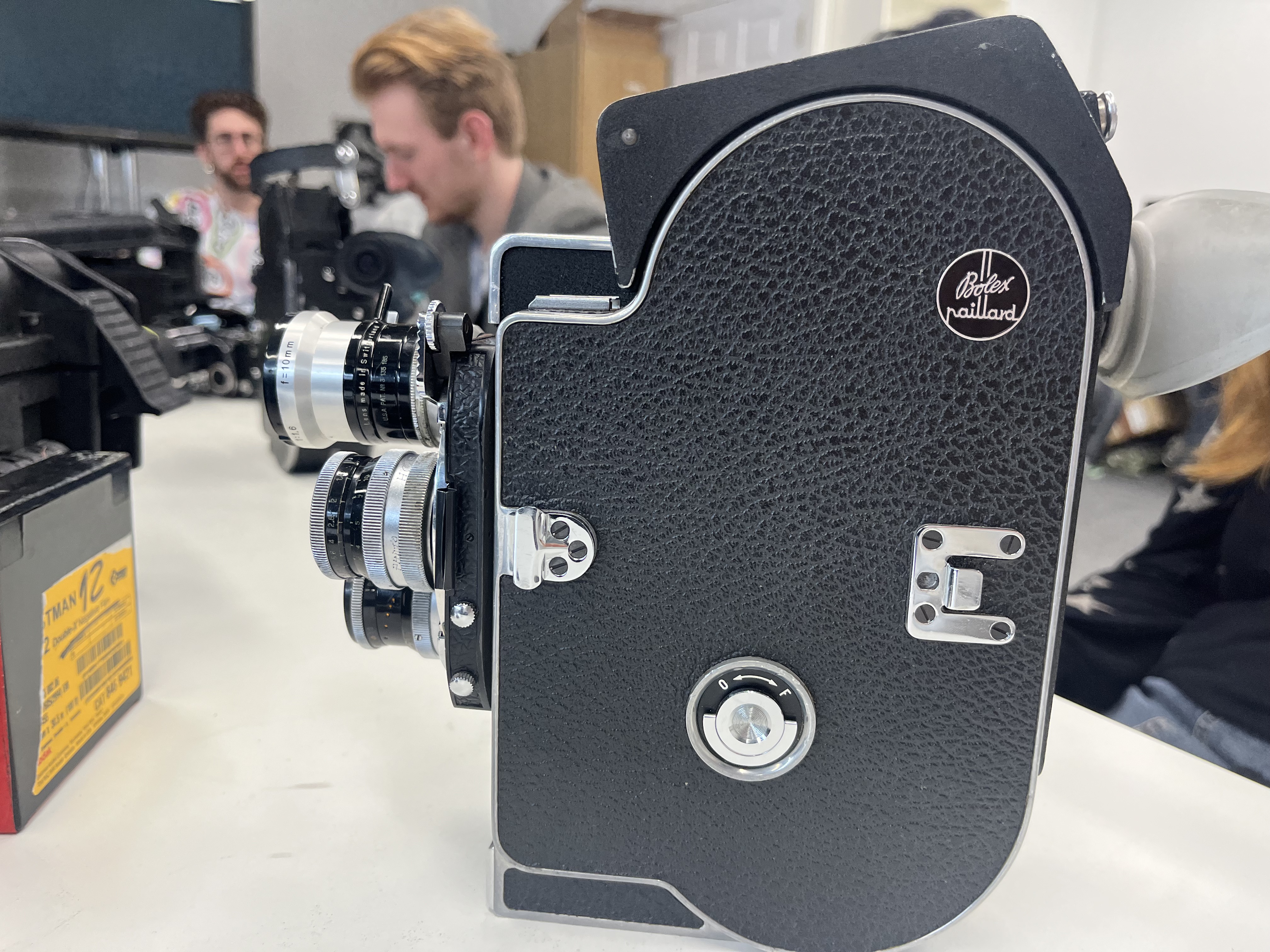
20/03/2024
Today I read ‘Speed and Politics’ by Paul Virilio where he explores the relationship between speed, technology and power, arguing that the speed at which our society is changing in the world of technology affects the world of politics. He talks about dromology, which is the study of speed and its effects on society, suggesting that the history of civilisation can be understood through the lens of acceleration and technological advancements. This heavily relates to Marx’s theory where it is industry and capitalism that have pushed society forward. He also mentions warfare and the speed at which the military are trained to quickly take others territory. The current (and historic) politics regarding the need to control someone’s land has lead to the development of faster weapons, transportation and communication technologies. He says that speed has made the nature of conflict more instantaneous and unpredictable. He goes on to critique accelerationism, which advocates for the rapid advancement of technology either in a capitalist sense; to create the greatest form of capitalism possible, or in a leftist sense; to bring about capitalist downfall. He warns against this acceleration, arguing that it can lead to economical destruction and social alienation, particularly between the classes. He then goes on to talk about urbanisation and how the proliferation of highways, high-speed railways, and air travel has changed the organisation of cities, leaving them congested and with a clear class divide. The way that communication has evolved has affected the speed at which technology is changing. Virilio argues that the easy ways in which information can now be transmitted has caused an increase in misinformation and manipulation of public opinion. He then reflects on the ecological consequences of speed, highlighting the depletion of natural resources, pollution and climate change caused by industrialisation and calls for a re-evaluation of our relationship with the environment. I really enjoyed reading Virilio’s thoughts on the current climate and I will definitely use some of his ideas in my piece, calling to slow down our accelerated culture in order to help us understand where we are in the here and now. While Virilio speaks a lot about the effect on politics, I want to delve into the effect on people and how we as a society have been affected by the constant need to improve and move forward.
‘”History progresses at the speed of its weapons systems”’ pg11
‘Echoing Heidegger, he writes that “dromocratic intelligence is not exercised against a more or less determined military adversary, but as a permanent assault on the world, and through it, on human nature”’ pg14
‘Todays information is architecture by other means’ pg16
‘The city is in essence a bunker, characterised by Virilio as a deliberate “reduction of power in favor of a better trajectory, life traded for survival”’ pg20
‘(Trotsky, 1914) “the static phases of their psychology then give way to the dynamic phases”’ pg57
‘It represents the revival of capitalism because it is none other than the technical surpassing of the old fortified place, which was rendered obsolete and dismantled by the power of the new State armies. This is the answer to exorbitant economic requirements of the continental military class, to its claim to dominate the flows of terrestrial traffic’ pg64
‘history progresses at the speed of its weapon systems’ pg90
‘when they try to unite in their hands alone the twin schemas of spatial appropriation of territory, robbing the native populations by trying to reduce their descendants to the level of servi casati, to the fate of tenant slaves- manpower deprived of its right to military defence’ pg95
‘Financial politics are exercised around abduction of persons, ransom systems; social protection leads to the perversion of charity into bodily assistance, of poverty into the power of money- to such an extent that when these great mechanisms stop functioning profitably, the Roman papacy of monks collapses’ pg113
‘Technologies of body and soul are thus strangely complexified in American pop-culture' pg128
‘the utopian use of defence reflexes leads us to modify aesthetics and the nature of production’ pg144
24/03/2024
Finalising and Filming
This week, I also finalised the song and began filming some of the visuals of myself. I used Adobe Audition to add the lyrics to an AI generated song and filmed myself in my room singing to it which will be used as some of the visuals for the piece. I now need to bring all the visuals I have so far together and compile a first draft for the video.
This week I learnt more about my subject of accelerationism and how to write a song. I also learnt about filming on my own and how best to record myself for the project.
For next week, I need to continue to think about my visuals and how I might want to start putting the piece together.
30/03/2024
First Edit
This week, I researched how to edit the sound of my piece so that my voice sounds more techno and, arguably, better. I used several YouTube tutorials and made my voice sound better. After doing so, however, I would like to re-record the song next week as I am still not 100% happy with it. Here are some of the videos I watched:
https://youtu.be/JriE-M3tqco?si=pf850us7eojgfBJ6
https://youtu.be/uN4PopM5Ly4?si=x0kTxEA2cQRG1Lbi
https://youtu.be/ll6oNny4AgQ?si=TjUlEA1SUgpsbE1T
https://youtu.be/uHDuhRRyyOc?si=g9ZD8cf1qEmCyE_E
I also did some more analogue visuals in the style of paintings and began to compile my video. I used both the footage I captured last week, some of the stock footage and my own home videos. You can see the first version of the video here:
This week I learnt how to edit my piece in a productive way and how to make the sound seem more in line with the idea I’m going for.
For next week, I need to continue to think about the visuals for the piece and begin compiling the animation additions so that I can finish the video in time for the crit session.
07/04/2024
Final Project
This week, I did some more research regarding changing my voice in the song so that I sound better and more electronic. However, I did not find any more help with regards to this and so I did some practical research in Adobe Audition and changed the settings to suit the style I needed.
This week I finished all the visuals and put the whole video together on Premiere Pro. It took me a very long time to finish the animation parts of the piece but I am relatively happy with the result I’ve managed to produce. Bate and Rubenstein talk about how data is being reworked through algorithms rather than through humans and that media is a technological framework of the psyche and so I have used these ideas to inform my own work, taking into consideration these algorithms and the connections people have to analogue media. I have also taken a lot of inspiration from theorists such as Paul Virilio, Karl Marx and Sigmund Freud, drawing upon their views on society and it’s accelerated culture causing us to move swiftly with the rise of capitalism. My piece demonstrates how this move happens with both analogue (with film photography, videography and stop motion) and digital media (photography, videography, hand-drawn animation and puppet animation). It draws upon the theme of memory by harkening back to a time of nostalgia for many people, particularly relating to my own experiences. I am satisfied with my project but I would have liked to have worked with a music student to help write a song rather than rely on AI as I don’t think the song is particularly great, nor are my vocals. If I could develop my idea further, I’d spend more time on the hand-drawn animations and make sure I took more visuals for the piece as I feel it may be a bit repetitive and some of the visuals could have been enhanced if I had asked some of my course-mates to help with my project (they did help me a little but I regret not asking for more). Overall, I am happy with my project and am confident that it relates well to the brief.
This week I learnt how to animate hand-drawn animations on a large scale and how to go about spending my time with little time left to finish the project.
Tomorrow we are presenting our projects to the group so I must be prepared to talk about my project and how it relates to the brief.
08/04/2024
During the crit session on Monday 8th April, I enjoyed seeing everyone’s work and getting some critical feedback on my own. Despite my dislike for my project, my peers reassured me that they enjoyed it and how many different piece of media I used throughout. Many also pointed out the blurring between technology and the physical world, highlighting how we are becoming more and more digital as time progresses. The style was very 80s and 90s music video style and was mentioned as being very clear in relation to the brief.
![]()
One thing that I noticed, however, was how quite my voice seemed in relation to the music and so I went away and edited the sound so that it can be heard better. Unfortunately, some of the vocals are now out of sync but I don’t have time to rectify this so if I were to do it again, I’d have a plan regarding the visuals in relation to the vocals so that they match up poetically as well as sync up nicely.
Here is my final, finished project:
‘Speed and Politics’ by Paul Virilio
Today I read ‘Speed and Politics’ by Paul Virilio where he explores the relationship between speed, technology and power, arguing that the speed at which our society is changing in the world of technology affects the world of politics. He talks about dromology, which is the study of speed and its effects on society, suggesting that the history of civilisation can be understood through the lens of acceleration and technological advancements. This heavily relates to Marx’s theory where it is industry and capitalism that have pushed society forward. He also mentions warfare and the speed at which the military are trained to quickly take others territory. The current (and historic) politics regarding the need to control someone’s land has lead to the development of faster weapons, transportation and communication technologies. He says that speed has made the nature of conflict more instantaneous and unpredictable. He goes on to critique accelerationism, which advocates for the rapid advancement of technology either in a capitalist sense; to create the greatest form of capitalism possible, or in a leftist sense; to bring about capitalist downfall. He warns against this acceleration, arguing that it can lead to economical destruction and social alienation, particularly between the classes. He then goes on to talk about urbanisation and how the proliferation of highways, high-speed railways, and air travel has changed the organisation of cities, leaving them congested and with a clear class divide. The way that communication has evolved has affected the speed at which technology is changing. Virilio argues that the easy ways in which information can now be transmitted has caused an increase in misinformation and manipulation of public opinion. He then reflects on the ecological consequences of speed, highlighting the depletion of natural resources, pollution and climate change caused by industrialisation and calls for a re-evaluation of our relationship with the environment. I really enjoyed reading Virilio’s thoughts on the current climate and I will definitely use some of his ideas in my piece, calling to slow down our accelerated culture in order to help us understand where we are in the here and now. While Virilio speaks a lot about the effect on politics, I want to delve into the effect on people and how we as a society have been affected by the constant need to improve and move forward.
‘”History progresses at the speed of its weapons systems”’ pg11
‘Echoing Heidegger, he writes that “dromocratic intelligence is not exercised against a more or less determined military adversary, but as a permanent assault on the world, and through it, on human nature”’ pg14
‘Todays information is architecture by other means’ pg16
‘The city is in essence a bunker, characterised by Virilio as a deliberate “reduction of power in favor of a better trajectory, life traded for survival”’ pg20
‘(Trotsky, 1914) “the static phases of their psychology then give way to the dynamic phases”’ pg57
‘It represents the revival of capitalism because it is none other than the technical surpassing of the old fortified place, which was rendered obsolete and dismantled by the power of the new State armies. This is the answer to exorbitant economic requirements of the continental military class, to its claim to dominate the flows of terrestrial traffic’ pg64
‘history progresses at the speed of its weapon systems’ pg90
‘when they try to unite in their hands alone the twin schemas of spatial appropriation of territory, robbing the native populations by trying to reduce their descendants to the level of servi casati, to the fate of tenant slaves- manpower deprived of its right to military defence’ pg95
‘Financial politics are exercised around abduction of persons, ransom systems; social protection leads to the perversion of charity into bodily assistance, of poverty into the power of money- to such an extent that when these great mechanisms stop functioning profitably, the Roman papacy of monks collapses’ pg113
‘Technologies of body and soul are thus strangely complexified in American pop-culture' pg128
‘the utopian use of defence reflexes leads us to modify aesthetics and the nature of production’ pg144
24/03/2024
Finalising and Filming
This week, I also finalised the song and began filming some of the visuals of myself. I used Adobe Audition to add the lyrics to an AI generated song and filmed myself in my room singing to it which will be used as some of the visuals for the piece. I now need to bring all the visuals I have so far together and compile a first draft for the video.
This week I learnt more about my subject of accelerationism and how to write a song. I also learnt about filming on my own and how best to record myself for the project.
For next week, I need to continue to think about my visuals and how I might want to start putting the piece together.
30/03/2024
First Edit
This week, I researched how to edit the sound of my piece so that my voice sounds more techno and, arguably, better. I used several YouTube tutorials and made my voice sound better. After doing so, however, I would like to re-record the song next week as I am still not 100% happy with it. Here are some of the videos I watched:
https://youtu.be/JriE-M3tqco?si=pf850us7eojgfBJ6
https://youtu.be/uN4PopM5Ly4?si=x0kTxEA2cQRG1Lbi
https://youtu.be/ll6oNny4AgQ?si=TjUlEA1SUgpsbE1T
https://youtu.be/uHDuhRRyyOc?si=g9ZD8cf1qEmCyE_E
I also did some more analogue visuals in the style of paintings and began to compile my video. I used both the footage I captured last week, some of the stock footage and my own home videos. You can see the first version of the video here:
This week I learnt how to edit my piece in a productive way and how to make the sound seem more in line with the idea I’m going for.
For next week, I need to continue to think about the visuals for the piece and begin compiling the animation additions so that I can finish the video in time for the crit session.
07/04/2024
Final Project
This week, I did some more research regarding changing my voice in the song so that I sound better and more electronic. However, I did not find any more help with regards to this and so I did some practical research in Adobe Audition and changed the settings to suit the style I needed.
This week I finished all the visuals and put the whole video together on Premiere Pro. It took me a very long time to finish the animation parts of the piece but I am relatively happy with the result I’ve managed to produce. Bate and Rubenstein talk about how data is being reworked through algorithms rather than through humans and that media is a technological framework of the psyche and so I have used these ideas to inform my own work, taking into consideration these algorithms and the connections people have to analogue media. I have also taken a lot of inspiration from theorists such as Paul Virilio, Karl Marx and Sigmund Freud, drawing upon their views on society and it’s accelerated culture causing us to move swiftly with the rise of capitalism. My piece demonstrates how this move happens with both analogue (with film photography, videography and stop motion) and digital media (photography, videography, hand-drawn animation and puppet animation). It draws upon the theme of memory by harkening back to a time of nostalgia for many people, particularly relating to my own experiences. I am satisfied with my project but I would have liked to have worked with a music student to help write a song rather than rely on AI as I don’t think the song is particularly great, nor are my vocals. If I could develop my idea further, I’d spend more time on the hand-drawn animations and make sure I took more visuals for the piece as I feel it may be a bit repetitive and some of the visuals could have been enhanced if I had asked some of my course-mates to help with my project (they did help me a little but I regret not asking for more). Overall, I am happy with my project and am confident that it relates well to the brief.
This week I learnt how to animate hand-drawn animations on a large scale and how to go about spending my time with little time left to finish the project.
Tomorrow we are presenting our projects to the group so I must be prepared to talk about my project and how it relates to the brief.
08/04/2024
Final Crit
During the crit session on Monday 8th April, I enjoyed seeing everyone’s work and getting some critical feedback on my own. Despite my dislike for my project, my peers reassured me that they enjoyed it and how many different piece of media I used throughout. Many also pointed out the blurring between technology and the physical world, highlighting how we are becoming more and more digital as time progresses. The style was very 80s and 90s music video style and was mentioned as being very clear in relation to the brief.

One thing that I noticed, however, was how quite my voice seemed in relation to the music and so I went away and edited the sound so that it can be heard better. Unfortunately, some of the vocals are now out of sync but I don’t have time to rectify this so if I were to do it again, I’d have a plan regarding the visuals in relation to the vocals so that they match up poetically as well as sync up nicely.
Here is my final, finished project: